Aswath Damodaran's Blog, page 3
December 11, 2024
For the fun of it: An Open House for my Spring 2025 Classes
My Motives for Teaching
I was in the second year of my MBA program at UCLA, when I had my moment on grace. I had taken a job as a teaching assistant, almost entirely because I needed the money to pay my tuition and living expenses, and in a subject (accounting) that did not excite me in the least. A few minutes after I walked in to teach my first class, I realized that I had found what I wanted to do for the rest of my life, and I have been a teacher ever since. Since that was 1983, this will be my forty first year teaching, and I have never once regretted my choice. I know that teaching is not a profession held in high esteem anymore, for good and bad reasons, and I will not try to defend it here. It is possible that some of the critics are right, and I teach because I cannot do, but I like to think that there is more to my career choice than ineptitude. My motivations for teaching are manifold, and let me list some of them:I like the stage: I believe that every teacher, to some extent, has a little bit of a repressed actor in him or her, and I do enjoy being in front of an audience, with the added benefit that I get to review the audience, with the grades that I given them, rather than the other way around.I like to make a difference: I do not expect my students to agree with all or even much of what I have to say, but I would like to think that I sometimes change the way they think about finance, and perhaps even affect their choice of professions. I am lucky enough to hear from students who were in my classes decades ago, and to find out that my teaching made a difference in their lives. I like not having a boss: I would be a terrible employee, since I am headstrong, opinionated and awfully lazy, especially when I must do things I don’t like to do. As a teacher, I am my own boss and find my foibles completely understandable and forgivable.I know that teaching may not be your cup of tea, but I do hope that you enjoy whatever you do, as much as I do teaching, and I would like to think that some of that joy comes through.
My Teaching Process
I do a session on how to teach for business school faculty, and I emphasize that there is no one template for a good teacher. I am an old-fashioned lecturer, a control freak when it comes to what happens in my classroom. In forty years of teaching, I have never once had a guest lecturer in my classroom or turned my class over to a free-for-all discussion.Class narrative: This may be a quirk of mine, but I stay away from teaching classes that are collections of topics. In my view, having a unifying narrative not only makes a class more fun to teach, but also more memorable. As you look at my class list in the next section, you will note that each of the classes is built around a story line, with the sessions building up to what is hopefully a climax.Bulking up the reasoning muscle: When asked a question in class, even if I know the answer, I try to not only reason my way to an answer, but to also be open about doubts that I may have about that answer. In keeping with the old saying that it is better to teach someone to fish, than to give them fish, I believe it is my job to equip my students with the capacity to come up with answers to questions that they may face in the future. In my post on the threat that AI poses to us, I argued that one advantage we have over AI is the capacity to reason, but that the ease of looking up answers online, i.e., the Google search curse, is eating away at that capacity.Make it real: I know that, and especially so in business schools, students feel that what they are learning will not work in the real world. I like to think that my classes are firmly grounded in reality, with my examples being real companies in real time. I am aware of the risks that when you work with companies in real time, your mistakes will also play out in real time, but I am okay with being wrong. Straight answers: When I was a student, I remember being frustrated by teachers, who so thoroughly hedged themselves, with the one hand and the other hand playing out, that they left me unclear about what they were saying. I would like to think that I do not hold back, and that I stay true to the motto that I would rather be transparently wrong than opaquely right. It has sometimes got me some blowback, when I expressed my views about value investing being rigid, ritualistic and righteous and the absolute emptiness of virtue concepts like ESG and sustainability, but so be it.I am aware of things that I need to work on. My ego sometimes still gets in the way of admitting when I am wrong, I often do not let students finish their questions before answering them, I am sometimes more abrupt (and less kind) than I should be, especially when I am trying to get through material and my jokes can be off color and corny (as my kids point out to me). I do keep working on my teaching, though, and if you are a teacher, no matter what level you teach at, I think of you as a kindred spirit.
My Class Content
In my first two years of teaching, from 1984 to 1986, I was a visiting professor at the University of California at Berkeley, and like many visiting faculty around the world, I was asked to plug in holes in the teaching schedule. I taught six different classes ranging from a corporate finance class to undergraduates to a central banking for executive MBAs, and while I spent almost all of my time struggling to stay ahead of my students, with the material, it set me on a pathway to being a generalist. Once I came to NYU in 1986, I continued to teach classes across the finance spectrum, from corporate finance to valuation to investing, and I am glad that I did so. I am a natural dabbler, and I enjoy looking at big financial questions and ideas from multiple perspectives. There are two core classes that I have taught to the MBAs at Stern, almost every year since 1986. The first is corporate finance, a class about the first principles that should govern how to run a business, and thus a required class (in my biased view) for everyone in business.
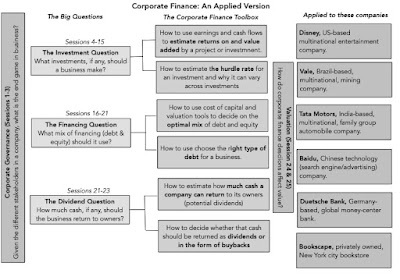
If you are a business owner or operator, this class should give you the tools to use to make business choices that make the most financial sense. If you work in a business, whether it be in marketing, strategy or HR, this class is designed to provide perspective on how what you do fits into value creation at your business. If you are just interested in business, just as an observer, you may find this class useful in examining why companies do what they do, from acquisitions to buybacks, and when corporate actions violate common sense.
The second is valuation, a class about how to value or price almost anything, with a tool set for those who need to put numbers on assets.
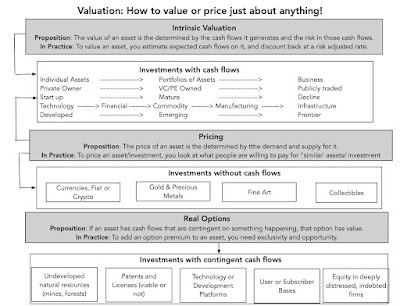
Again, I teach this class to a broad audience, from appraisers/analysts whose jobs revolve around valuation/pricing to portfolio managers who are often users of analyst valuations to business owners, whose interests in valuation can range from curiosity (how much is my business worth?) to the transactional (how much of my business should I give up for a capital infusion?)
While my class schedule has been filled with these two courses, I developed a third course, investment philosophies, a class about how to approach investing, trying to explain why investors with very different market views and investment strategies can co-exist in a market, and why there is no one philosophy that dominates.
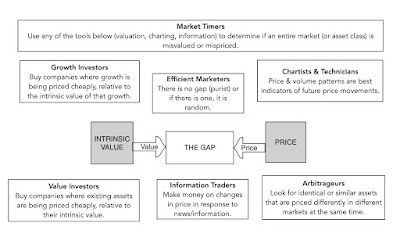
My endgame for this class is to provide as unbiased a perspective as I can for a range of philosophies from trading on price patterns to market timing, with stops along the way from value investing, growth investing and information trading. It is my hope that this class will allow you to find the investment philosophy that best fits you, given your financial profile and psychological makeup.
In 2024, I added a fourth course to the mix, one centered around my view that businesses age like human beings do, i.e., there is a corporate life cycle, and that how businesses operate and how investors value them, changes as they move from youth to demise.
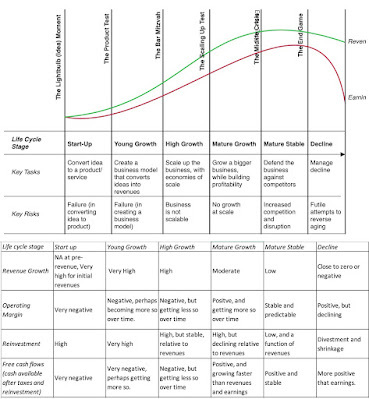
I have used the corporate life cycle perspective to structure my thinking on almost every class that I teach, and in this class, I isolate it to examine how businesses age and how they respond to to aging, sometimes in destructive ways.
In my corporate finance and valuation classes, the raw material comes from financial statements, and I realized early on that my students, despite having had a class or two on accounting, still struggled with reading and using financial statements, and I created a short accounting class, specifically designed with financial analysis and valuation in mind. The class is structured around the three financial statements that embody financial reporting - the income statement, balance sheet and statement of cash flows - and how the categorization (and miscategorization) of expenses into operating, financing and capital expenses plays out in these statements.
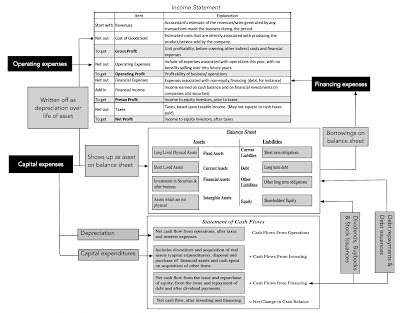 As many of you who may have read my work know, I think that fair value accounting is not just an oxymoron but one that has done serious damage to the informativeness of financial statements, and I use this class to explain why.
As many of you who may have read my work know, I think that fair value accounting is not just an oxymoron but one that has done serious damage to the informativeness of financial statements, and I use this class to explain why.Since so much of finance is built around the time value of money (present value) and an understanding of financial markets and securities, I also have a short online foundational class in finance:
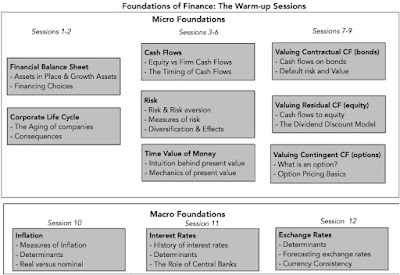 As you can see, this class covers the bare basics of macroeconomics, since that is all I am capable to teaching, but in my experience, it is all that I have needed in finance.
As you can see, this class covers the bare basics of macroeconomics, since that is all I am capable to teaching, but in my experience, it is all that I have needed in finance.As our access to financial data and tools has improved, I added a short course on statistics, again with the narrow objective of providing the basic tools of data analysis.
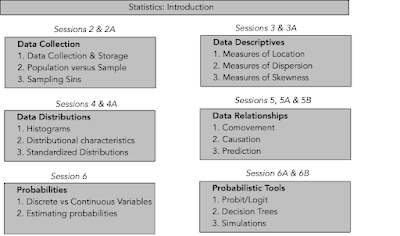
A statistics purist would probably blanch at my treatment of regressions, correlations and descriptive statistics, but as a pragmatist, I am willing to compromise and move along. As you browse through the content of these classes, and consider whether you want to take one, it is worth noting that they are taught in different formats. The corporate finance and valuation classes will be taught in the spring, starting in late January and ending in mid-May, with two eighty-minute sessions each week that will be recorded and accessible shorts after they are delivered in the classroom. There are online versions of both classes, and the investment philosophies class, that take the form of shorter recorded online classes (about twenty minutes), that you can either take for free on my webpage or for a certificate from NYU, for a fee.

The accounting, statistics and foundations classes are only in online format, on my webpage, and they are free. All in all, I know that some of you are budget-constrained, and others of you are time-constrained, and I hope that there is an offering that meeting your constraints.
If you are interested, the table below lists the gateways to each of the classes listed above. Note that the links for the spring 2025 classes will lead you to webcast pages, where there are no sessions listed yet, since the classes start in late January 2025. The links to the NYU certificate classes will take you to the NYU page that will allow you to enroll if you are interested, but for a price. The links to the free online classes will take you to pages that list the course sessions, with post-class tests and material to go with each session: table.tableizer-table { font-size: 12px; border: 1px solid #CCC; font-family: Arial, Helvetica, sans-serif; } .tableizer-table td { padding: 4px; margin: 3px; border: 1px solid #CCC; } .tableizer-table th { background-color: #104E8B; color: #FFF; font-weight: bold; }ClassNYU Spring 2025 Online (free)NYU CertificateWhatsApp Discussion Group Corporate FinanceLinkLinkLink (Fall)Link ValuationLinkLinkLink (Spring & Fall)Link Investment PhilosophiesNALinkLink (Spring)Link Corporate Life CycleNALinkNALink AccountingNALinkNA Foundations of FinanceNALinkNA StatisticsNALinkNA
The last column represents WhatsApp groups that I have set up for each class, where you can raise and answer questions from others taking the class.
My Book (and Written) Content Let me begin by emphasizing that you do not need any of my books to take my classes. In fact, I don't even require them, when I teach my MBA and undergraduate classes at NYU. The classes are self contained, with the material you need in the slides that I use for each class, and these slides will be accessible at no cost, either as a packet for the entire class or as a link to the session (on YouTube). To the extent that I use other material, spreadsheets or data in each session, the links to those as well will be accessible as well.
If you prefer to have a book, I do have a few that cover the classes that I teach, though some of them are obscenely overpriced (in my view, and there is little that I can do about the publishing business and its desire for self immolation.) You can find my books, and the webpages that support these books, at this link, and a description of the books is below:
table.tableizer-table { font-size: 12px; border: 1px solid #CCC; font-family: Arial, Helvetica, sans-serif; } .tableizer-table td { padding: 4px; margin: 3px; border: 1px solid #CCC; } .tableizer-table th { background-color: #104E8B; color: #FFF; font-weight: bold; }Corporate Finance Valuation Investment Philosophies Corporate Life Cycle Applied Corporate Finance (Wiley, 4th Ed): This is the book that is most closely tied to this class and represents my views of what should be in a corporate finance class most closely. Investment Valuation (Wiley, 3rd Ed, 4th ed forthcoming): This is my only valuation textbook, designed for classroom teaching. At almost 1000 pages, it is overkill but it is also the most comprehensive of the books in terms of coverage. Investment Philosophies (Wiley, 2nd Ed): This is the best book for this class, and provides background and evidence for each investment philosophy, with a listing of the personal characteristics that you need to make that philosophy work for you. Corporate Life Cycle (Penguin Random House, 1st Ed): This is the most recent of my books and it introduces the phases of the corporate life cycle and why business, management, valuation and investment challenges change with each phase. Corporate Finance (Wiley, 2nd Ed): This is a more conventional corporate finance book, but it has not seen a new edition in almost 20 years. Little Book of Valuation (Wiley, 2nd Ed): This is the shortest of the books, but it provides the essentials of valuation, and at a reasonable price. Investment Management (Wiley, 1st Ed): This is a very old book, and one that I co-edited with the redoubtable Peter Bernstein, focused on writings on different parts of the investment process. It is dated but it still has relevance (in my view). Strategic Risk Taking (Wharton, 1s Ed): This is a book specifically about measuring risk, dealing with risk and how risk taking/avoidance affect value. Dark Side of Valuation (Prentice Hall, 3rd Ed): This is a book about valuing difficult-to-value companies, from young businesses to cyclical/commodity companies. It is a good add-on to the valuation class. Investment Fables (FT Press, 1st Ed): This book is also old and badly in need of a second edition, which I may turn to next year, but it covers stories that we hear about how to beat the market and get rich quickly, the flaws in these stories, and why it pays to be a skeptic. Damodaran on Valuation (Wiley, 2nd Ed): This was my very first book, and it is practitioner-oriented, with the second half of the book dedicated to loose ends in vlauation (control, illiquidity etc.) Narrative and Numbers (Columbia Press, 1st Ed): This was the book I most enjoyed writing, and it ties storytelling to numbers in valuation, providing a basis for my argument that every good valuation is a bridge between stories and numbers.
Finally, I discovered early on how frustrating it is to be dependent on outsiders for data that you need for corporate financial analysis and valuation, and I decided to become self sufficient and create my own data tables, where I report industry averages on almost every statistic that we track and estimate in finance. These data tables should be accessible and downloadable (in excel), and if you find yourself stymied, when doing so, trying another browser often helps. The data is updated once a year, at the start of the year, and the 2025 data update will be available around January 10, 2025.
A Class Guide I would be delighted, if you decide to take one or more of my classes, but I understand that your lives are busy, with jobs, family and friends all competing for your time. You may start with the intent of taking a course, but you may not be able to finish for any number of reasons, and if that happens, I completely understand. In addition, the courses that you find useful will depend on your end game.If you own a business, work in the finance department of a company, or are a consultant, you may find the corporate finance course alone will suffice, providing most of what you need.If you are in the appraisal or valuation business, either as an appraiser or as an equity research analyst (buy or sell side), valuation is the class that will be most directly tied to what you will do. I do believe that to value businesses, you need to understand how to run them, making corporate finance a good lead in.If you plan to be in active investment, working at a mutual fund, wealth management or hedge fund, or are an individual investor trying to find your way in investing, I think that starting with a valuation class, and following up with investment philosophy will yield the biggest payoff.Finally, the corporate life cycle class, which spans corporate finance, valuation and investing, with doses of management and strategy, will be a good add on to any of the other pathways, or as a standalone for someone who has little patience for finance classes but wants a framework for understanding businesses.As a lead-in to any of these paths, I will leave it to you to decide whether you need to take the accounting, statistics, and foundations classes, to either refresh content you have not seen in a long time or because you find yourself confused about basics:
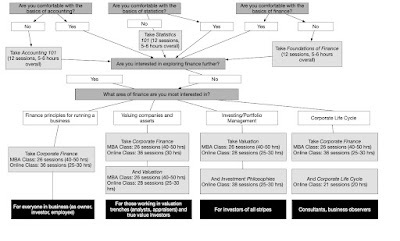 If you find yourself overwhelmed with any or all of these paths, you always have the option of watching a session or two of any class of your choice. As you look at the choices, you have to consider three realities. The first is that, unless you happen to be a NYU Stern student, you will be taking these classes online and asynchronously (not in real time). As someone who has been teaching online for close to two decades now, I have learned that watching a class on a computer or display screen is far more draining than being in a physical class, which is one reason that I have created the online versions of the classes with much shorter session lengths. The second is that the biggest impediment to finishing classes online, explaining why completion rates are often 5% or lower, even for the best structured online classes, is maintaining the discipline to continue with a class, when you fall behind. While my regular classes follow a time line, you don't have to stick with that calendar constraint, and can finish the class over a longer period, if you want, but you will have to work at it. The third is that learning, especially in my subject area, requires doing, and if all you do is watch the lecture videos, without following through (by trying out what you have learned on real companies of your choosing), the material will not stick. I will be teaching close to 800 students across my three NYU classes, in the spring, and they will get the bulk of my attention, in terms of grading and responding to emails and questions. With my limited bandwidth and time, I am afraid that I will not be able to answer most of your questions, if you are taking the free classes online; with the certificate classes, there will be zoom office hours once every two weeks for a live Q&A. I have created WhatsApp forums (see class list above) for you, if you are interested, to be able to interact with other students who are in the same position that you are in, and hopefully, there will be someone in the forum who can address your doubts. Since I have never done this before, it is an experiment, and I will shut them down, if the trolls take over.
If you find yourself overwhelmed with any or all of these paths, you always have the option of watching a session or two of any class of your choice. As you look at the choices, you have to consider three realities. The first is that, unless you happen to be a NYU Stern student, you will be taking these classes online and asynchronously (not in real time). As someone who has been teaching online for close to two decades now, I have learned that watching a class on a computer or display screen is far more draining than being in a physical class, which is one reason that I have created the online versions of the classes with much shorter session lengths. The second is that the biggest impediment to finishing classes online, explaining why completion rates are often 5% or lower, even for the best structured online classes, is maintaining the discipline to continue with a class, when you fall behind. While my regular classes follow a time line, you don't have to stick with that calendar constraint, and can finish the class over a longer period, if you want, but you will have to work at it. The third is that learning, especially in my subject area, requires doing, and if all you do is watch the lecture videos, without following through (by trying out what you have learned on real companies of your choosing), the material will not stick. I will be teaching close to 800 students across my three NYU classes, in the spring, and they will get the bulk of my attention, in terms of grading and responding to emails and questions. With my limited bandwidth and time, I am afraid that I will not be able to answer most of your questions, if you are taking the free classes online; with the certificate classes, there will be zoom office hours once every two weeks for a live Q&A. I have created WhatsApp forums (see class list above) for you, if you are interested, to be able to interact with other students who are in the same position that you are in, and hopefully, there will be someone in the forum who can address your doubts. Since I have never done this before, it is an experiment, and I will shut them down, if the trolls take over.In Closing…
I hope to see you (in person or virtually) in one of my classes, and that you find the content useful. If you are taking one of my free classes, please recognize that I share my content, not out of altruism, but because like most teachers, I like a big audience. If you are taking the NYU certificate classes, and you find the price tag daunting, I am afraid that I cannot do much more than commiserate, since the university has its own imperatives. If you do feel that you want to thank me, the best way you can do this is to pass it on, perhaps by teaching someone around you.
YouTube Video
Class list with linksCorporate Finance (NYU MBA): https://pages.stern.nyu.edu/~adamodar/New_Home_Page/webcastcfspr25.htm Valuation (NYU MBA): https://pages.stern.nyu.edu/~adamodar/New_Home_Page/webcasteqspr25.htm Corporate Finance (Free Online): https://pages.stern.nyu.edu/adamodar/New_Home_Page/webcastcfonline.htm Valuation (Free Online): https://pages.stern.nyu.edu/~adamodar/New_Home_Page/webcastvalonline.htm Corporate Finance (NYU Certificate): https://execed.stern.nyu.edu/products/corporate-finance-with-aswath-damodaran Valuation (NYU Certificate): https://execed.stern.nyu.edu/products/advanced-valuation-with-aswath-damodaran Investment Philosophies (Free Online): https://pages.stern.nyu.edu/~adamodar/New_Home_Page/webcastinvphil.htm Investment Philosophies (NYU Certificate): https://execed.stern.nyu.edu/products/investment-philosophies-with-aswath-damodaran Corporate Life Cycle (Free Online): https://pages.stern.nyu.edu/~adamodar/New_Home_Page/webcastCLC.htm Accounting 101 (Free Online): https://pages.stern.nyu.edu/~adamodar/New_Home_Page/webcastacctg.htm Foundations of Finance (Free Online): https://pages.stern.nyu.edu/~adamodar/New_Home_Page/webcastfoundationsonline.htm Statistics 101 (Free Online): https://pages.stern.nyu.edu/~adamodar/New_Home_Page/webcaststatistics.htmWhatsApp Groups for Classes
Corporate Finance: https://chat.whatsapp.com/C0yjIAWT2WdLozCHYctU9pValuation: https://chat.whatsapp.com/LjQBQXcbyh11I17idz176kInvestment Philosophies: https://chat.whatsapp.com/IolVsa3qScLJecUtu4uUKOCorporate Life Cycle: https://chat.whatsapp.com/J1V0vwFkIUoCblYp4J3ENs
November 14, 2024
The Siren Song of Sustainability: The Theocratic Trifecta's Third Leg!
You might know, by now, of my views on ESG, which I have described as an empty acronym, born in sanctimony, nurtured in hypocrisy and sold with sophistry. My voyage with ESG began with curiosity in my 2019 exploration of what it purported to measure, turned to cynicism as the answers to the Cui Bono (who benefits) question became clear and has curdled into something close to contempt, as ESG advocates rewrote history and retroactively changed their measurements in recent years. Late last year, I looked at impact investing, as a subset of ESG investing, and chronicled the trillions put into fighting climate change, and the absence of impact from that spending. Sometime before these assessments, I also looked at the notion of stakeholder wealth maximization as an idea that only corporate lawyers and strategists would love, and argued that there is a reason, in conventional businesses to stay focused on shareholders. With each of these topics (ESG, impact investing, stakeholder wealth maximization), the response that I got from some of the strongest defenders was that "sustainability" is the ultimate end game, and that the fault has been in execution (in ESG and impact investing), and not in the core idea.
I was curious about what sets sustainability apart from the critiqued ideas, as well as skeptical, since the cast of characters (individual and entities) in the sustainability sales pitch seems much the same as for the ESG and impact investing sales pitches. In critiquing sustainability, I may be swimming against the tide, but less so than I was five years ago, when I first wrote about these issues. In fact, in my first post on ESG, I confessed that I risked being labeled as a "moral troglodyte" for my views, and I am sure that my subsequent posts have made that a reality, but I have a thick skin. This post on sustainability will, if it is read, draw withering scorn from the righteous, and take me off their party invite list, but I don't like parties anyway.
Sustainability: The What, the Why and the Who?
I have been in business and markets for more than four decades, and while sustainability as an end game has existed through that period, but much of that time, it was in the context of the planet, not for businesses. It is in the last two decades that corporate sustainability has become a term that you see in academic and business circles, albeit with definitions that vary across users. Before we look at how those definitions have evolved, it is instructive to start with three measures of sustainability, measuring (in my view) very different things:
Planet sustainability, measuring how our actions, as consumers and businesses, affect the planet, and our collective welfare and well being. This, of course, covers everything from climate change to health care to income inequality.Product sustainability, measuring how long a product or service from a business can be used effectively, before becoming useless or waste. In a throw-away world, where planned obsolescence seems to be built into every product or service, there are consumers and governments who care about product sustainability, albeit for different reasons.Business or corporate sustainability, measuring the life of a business or company, and actions that can extend or constrict that life. There are corporate sustainability advocates who will argue that it covers all of the above, and that a business that wants to increase its sustainability has to make more sustainable products, and that doing so will improve planet sustainability. That may be true, in some cases, but in many, there will be conflicts. A company that makes shaving razors may be able to create razor blades that stay sharp forever, and need no replacement, but that increased product sustainability may crimp corporate sustainability. In the same vein, there may be some companies (and you can let your priors guide you in naming them), whose very existence puts the planet at risk, and if planet sustainability is the end game, the best thing that can happen is for these companies to cease to exist.Which of these measures of sustainability lies at the heart of corporate sustainability, as practiced today? To get the answers, I looked at a variety of players in the sustainability game, and will use their own words in the description, lest I be accused of taking them out of context:
Business schools around the world have discovered that sustainability classes not only draw well, and improve their rankings (especially with the Financial Times, which seems to have a fetish with the concept), but are also money makers when constructed as executive classes. NYU, the institution that I teach at, has an executive corporate sustainability course, with certification costing $2,200, but I will quote the Vanderbilt University course description instead, where for a $3,000 price tag, you can get a certificate in corporate sustainability, which is described as " a holistic approach to conducting business while achieving long-term environmental, social, and economic sustainability." Academia: I read through seminal and impactful (as academics, we are fond of both words, with the latter measured in citations) papers on corporate sustainability, to examine how they defined and measured sustainability. A 2003 paper on corporate sustainability describes it as recognizing that "corporate growth and profitability are important, it also requires the corporation to pursue societal goals, specifically those relating to sustainable development — environmental protection, social justice and equity, and economic development." In the last two decades, it is estimated that there have been more than twelve thousand articles published on corporate sustainability, and while the definition has remained resilient, it has developed offshoots and variants.Corporate/Business: Companies, around the world, were quick to jump onto the sustainability bandwagon, and sustainability (or something to that effect) is part of many corporate mission statements. The Hartford, a US insurance company, describes corporate sustainability as centered "around developing business strategies and solutions to serve the needs of our stakeholders, while embracing the necessary innovation and foresight to ensure we are able to meet those needs in the decades to come."Governments: Governments have also joined the party, and the EU has been the frontrunner, and its definition of corporate sustainability as "integrating social, environmental, ethical, consumer, and human rights concerns into their business strategy and operations" has become the basis for both disclosure and regulatory actions. The Canadian government has used to EU model to create a corporate sustainability reporting directive, requiring companies to report on and spend more on a host on environmental, social and governance indicators. I am willing to be convinced otherwise, but all of these definitions seem to be centered around planet sustainability, with varying motivations for why businesses should act on that front, from clean consciences (it is the right thing to do) to being "good for business" (if you do it, you will become more profitable and valuable).
While corporate sustainability has taken center stage in the last two decades, it is part of a discussion about the social responsibilities of businesses that has been around for centuries. From Adam Smith's description of economics as the "gospel of mammon" in the 1700s to Milton Friedman's full-throated defense of business in the 1970s, it can be argued that almost every debate about businesses has included discussions of what they should do for society, beyond just following the law. That said, corporate sustainability (and its offshoots) have clearly taken a more central role in business than ever before, and one manifestation is in the rise of "corporate sustainability officers" (CSOs) at many large companies. A PwC survey of 1640 companies in 62 countries, in 2022, found that the number of companies with CSOs tripled in 2021, with about 30% of all companies having someone in that position. A Conference Board survey of hundred sustainability leaders (take the sample bias into account) of the state of corporate sustainability pointed to the expectation that sustainability teams at companies would continue to grow over time. Finally, going back to academia, an indicator of the buzz in buzzwords, a survey paper in 2022 noted the rise in the number of corporate-sustainability related articles in recent years, as well as documenting their focus:
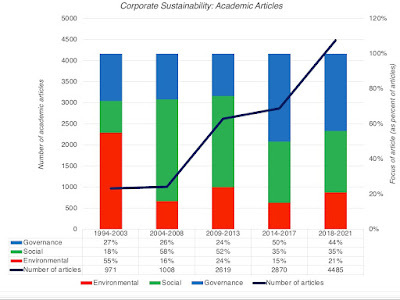 Burbano, Delma and Cobo (2022)
Burbano, Delma and Cobo (2022)
Note that much of the surge in articles came from ESG, which at least for the bulk of this period marched in lockstep with sustainability. Reflecting that twinning, many of the papers on corporate sustainability, just like the papers on ESG, were framed as sustainability being not just good for society but also good for the companies that adopted them.
I will admit that I have no idea what a CSO is or does, but I did get a chance to find out for myself, when I was invited to give a talk to the CSOs of fifty large companies. I started that session with a question, born entirely out of curiosity, to the audience of what they did, at their respective organizations. After about twenty minutes of discussion, it was very clear that there was no consensus answer. In fact, some were as in the dark, as I was, about a CSO's responsibilities and role, and among the many and sometimes convoluted and contradictory answers I heard, here was my categorization of potential CSO roles:CSO as Yoda: Some of the CSOs described their role as providing vision and guidance to the companies they worked at, about the societal effects of their actions, and doing so with a long term perspective. In short, even though they did not make this explicit, they were projecting that they had the training and foresight on how the company and society would evolve over time, and advice the company on the actions that it would need to take to match that evolution. I was tempted, though I restrained myself, to ask what training they had to be such receptacles of wisdom, since a degree or certification in sustainability clearly would not do the trick. I did dig into Star Wars lore, where it is estimated that it takes a decade or two of intense training to become a Jedi, and left open the possibility that there may be an institution somewhere that is turning out sustainability jedis.CSO as Jiminy Cricket: I am a fan of Disney movies, and Pinocchio, while not one of the best known, remains one of my favorites. If you have watched the movie, Jiminy Cricket is the character that sits on Pinocchio's shoulder and acts as his conscience, and for some of the CSOs in the audience, that seemed to be the template, i.e., to act as corporate consciences, reminding the companies that they work for, of the social effects of their actions. The problem, of course, is that like the Jiminy Cricket in the movie, they get tagged as relentless scolds, usually get ignored, and get little glory, even when proved right. CSO as PR Genius: There were a few CSOs who were open about the fact that they were effectively marketing fronts for companies, with the job of taking actions that could not remotely be argued as being good for the planet and selling them as such. I am not sure whether Unilever's CSO was involved in the process, but the company's push to have each of its four hundred brands have a social or environmental purpose would have fallen into this realm. CSO as Embalmer: Finally, there were some CSOs who argued that it was their job to ensure that the company would live longer, perhaps even forever. Like the embalmers who promised the Egyptian pharaohs everlasting life, if they wrapped themselves in bandages and buried themselves in crypts, these CSOs view longer corporate lives as the end game, and act accordingly. If you are familiar with my work on corporate life cycles, I believe that not much good comes from companies surviving as “walking dead” entities, but in a world where survival at any cost is viewed as success, it is a by product. Here are the roles in table form, with the training that would prepare you best for each one:
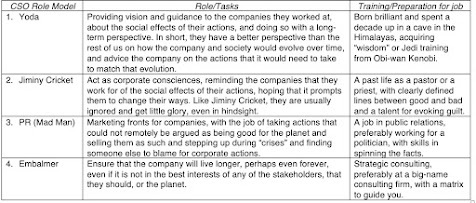
I am sure that I am missing some of the nuance in sustainability, but if so, remember that nuance does not survive well in business contexts, where a version of Gresham's law is at work, with the worst motives driving out the best.
Sustainability and ESG In the last two or three years, corporate sustainability advocates have tried to separate themselves from ESG, arguing that the faults of ESG are of its own doing, and came from ignoring sustainability lessons. I am sorry, but I don't buy it. If ESG did not exist, sustainability would have had to invent it, because much of the growth in sustainability as a concept and in practice has come from its ESG arm. As I see it, ESG took the noble sounding words of corporate sustainability and converted them into a score, and it was that much maligned scoring mechanism that caused a surge of adoptions both in corporate boardrooms and in investment funds. To complete the linkage, both ESG and sustainability draw on stakeholder wealth maximization, with the core thesis that businesses should be run for the benefit of all stakeholders, rather than “just” for shareholders. It is in this context that I used the "theocratic trifecta" to describe how ESG, sustainability and stakeholder wealth are linked, and have been marketed.
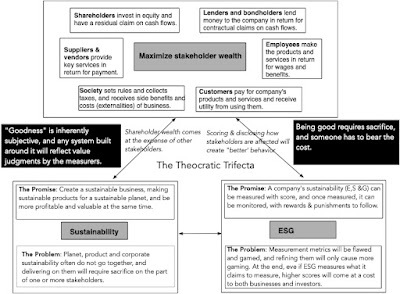 I use of the word “theocrat” deliberately, since like the theocrats of yore, some in these spaces believe that they own the high ground on virtue, and view dissent as almost sacrilegious.
I use of the word “theocrat” deliberately, since like the theocrats of yore, some in these spaces believe that they own the high ground on virtue, and view dissent as almost sacrilegious. While the ESG scoring mechanism, by itself, can be viewed as having a good purpose, i.e., to create a measure of how much a company is moving towards it sustainability goals, and to hold it accountable, it creates the natural consequences that come with all scoring mechanisms:Measurers claiming to be objective arbiters, when the truth is that all scores require subjective judgments about what comprises goodness, and the consequences for business profitability and value.Businesses that start to understand the scoring process and factors, and then game the scoring systems to improve their scores. Greenwashing is a feature of these scoring systems, not a bug, and the more you try to refine the scoring, the more sophisticated the gaming will become.Advocates wringing their hands about the gaming, and arguing that the answer is more detailed definitions of things that defy definition, not recognizing (or perhaps not caring) that this just feeds the cycle and creates even more gaming.With ESG, we have seen this process play out in destructive ways, with scores varying across services for the same companies, significant gaming around ESG scoring and more disclosure, but with little to show in tangible benefits for society. In fact, taking a step back and looking at ESG and sustainability as concepts, they share many of the same characteristics:They are opaque: Both ESG and sustainability are opaque to the point of obfuscation, perhaps because it serves the interests of advocates, who can then market them in whatever form they want to. To the pushback from defenders that the details are being nailed down or that there are new standards in place or coming, the argument runs hollow because the end game seems to keep changing. With ESG, for instance, the end game when it was initiated was making the world a better place (doing good), which evolved to generating alpha (excess returns for investors), on to being a risk measure before converting on a disclosure requirement. Defenders argue that there will be convergence driven by tighter definitions from regulators and rule makers, and the EU, in particular, has been in the lead on this front, putting out a Corporate Sustainability Reporting Directive (CSRD) in 2022, outlining economic activities that contribute to meeting the EU’s environmental objectives. While ESG advocates may be right about convergence, looking to the the bureaucracy in Brussels to have the good sense (on economics and sustainability) to get this right is analogous to asking a long-time vegan where you can get the best steak in town. They are rooted in virtue: While some of the advocates for ESG and sustainability have now steered away from goodness as an argument for their use, almost every debate about the two topics eventually ends up with advocates claiming to own the high ground on virtue, with critics consigned to the other side. Disclosures, over actions: The path for purpose-driven concepts (sustainability, ESG) seems to follow a familiar arc. They start with the endgame of making the world a better place, are marketed with the pitch that purpose and profits go together (the original sin) and when the the lie is exposed, are repackaged as being about disclosures that can be used by consumers and investors to make informed judgments. Both ESG and sustainability have traversed this path, and both seem to be approaching the "it's all about disclosure" component. While that seems like a reasonable outcome, since almost everyone is in favor of more information, there are two downsides to this disclosure drive. The first is that disclosure can become not just a substitute for acting, but an impediment to the change that makes a difference. The second is that as disclosures become more extensive, there is a tipping point, especially as the consequential disclosures are mixed in with minor ones, where users start ignoring the disclosure, effectively removing their information value. Underplay or ignore sacrifice: Of all the mistakes, the biggest one made in the sales pitch for ESG and sustainability was that you could eat your cake, and have it too. Companies were told that being sustainable would make them more profitable and valuable, investors were sold on the notion that investing in good companies would deliver higher or extra returns and consumers were informed that they could make sustainable choices, with little or no additional cost. The truth is that sustainability will be costly to businesses, investors, and consumers, and why should that surprise us? Through history, being good has always required sacrifice, and it was always hubris to argue that you could upend that history, with ESG and sustainability.Notwithstanding the money, time and resources that have been poured into ESG and sustainability, there is little in terms of real change on any of the social or climate problems that they purport to want to change.
Can sustainability be saved?
I may be a moral troglodyte, because of my views on ESG, sustainability and all things good, but I want my children and grandchildren to live in a better world than the one that I lived in. Put simply, we have a shared interest in making the world a better place, and that leads to the question of whether corporate sustainability, or at least the mission that it espouses, can be saved. I believe that there is a path forward, but it requires steps that many sustainability purists may find anathema:
Be clear eyed about what can be achieved at the business level: There is truth to the Milton Friedman adage that the business of business is business, not filling in for social needs or catering to non-business interests. It is true that there are actions that businesses take that can create costs to society, and even if the law does not require it, it behooves us all to get businesses to behave better. That said, the danger of overreaching here, and asking businesses to do what governments and regulators should be doing, is that it is not just ineffective but counter-production. For business sustainability to deliver results, it has to make that line (between business and government action) clearer.Open about the costs to businesses of meeting sustainability goals: Start being real about the sacrifices in profitability and value that will be needed for a company to do what's good for society. To the extent that in a publicly traded company, it is not the managers, but one of the stakeholders (shareholders, bondholders, employees or customer), who bear this cost, you need buy in from them, of the sustainability actions are voluntary. For companies that are well managed and have delivered success for their owners, the sacrifice may be easier to sell, but for badly managed businesses, it will be and should be a steep hill to climb. To the extent that corporate executives and fund managers have chosen the path of virtue, at a cost to their shareholders and investors, without their buy in, there is clearly a violation of fiduciary duty that will and should leave them exposed to legal consequences.Clear about who bears these costs: I was recently asked to give testimony to a Canadian parliamentary committee that was considering ways of getting banks to contribute to fighting climate change (by lending less to fossil fuel companies and more to green energy firms), and much of what I heard from committee members and the other experts was about how banks would bear the costs. The truth is that when a bank is either restricted from a profit-making activity or forced to subsidize a money-losing activity, the costs are borne by either the bank's shareholders or depositors, or, in some cases, by taxpayers. In fact, given that bank equity is such a small slice of overall capital, I argued that it bank depositors who will be burdened the most by bank lending mandates. And honest about cost sharing: One of the benefits of recognizing that being good (for the planet or society) creates costs is that we can then also follow up by looking at who bears the costs. It is my view that for much of the past few decades, we (as academics, policy makers and regulators) been far too quick to decide what works for the "greater good", at least as we see it, and much too blind to the reality that the costs of delivering that greater good are borne by the people who can least afford it. Above all, drain the gravy train: Drawing on a biblical theme, both ESG and sustainability have been contaminated by the many people and entities that have benefited monetarily from their existence. The path to making sustainability matter has to start by removing the grifters, many masquerading as academics and experts, from the space. I won’t name names, but if you want to see who you should be putting on that grifter list, many of them will be at the annual extravaganza called COP29, where the useful idiots and feckless knaves who inhabit this space will fly in from distant places to Azerbaijan, to lecture the rest of us on how to minimize our carbon footprint. If you are a business that cares about the planet, fire your sustainability consultants, stop listening to sustainability advisors or bending business models to meet CSRD needs, and fall back on common sense, and while you are at it, you may want to get rid of your CSO (if you have one), unless you have Yoda on your payroll. In all of this discussion, there is a real problem that no one in the space seems to be willing to accept or admit to, and that is much as we (as consumers, investors and voters) claim to care about social good, we are unwilling to burden ourselves, even slightly (by paying higher prices or taxes), to deliver that good. It could be because we are callous, or have become so, but I think the true reason is that we have lost trust in governments and institutions, and who can blame us? Whether it is the city of San Diego, where I live, trying to increase sales taxes by half a percent or a government imposing a carbon tax, taxpayers seem disinclined to given governments the benefit of doubt, given their history of inefficiencies and broken promises. One argument that I have heard from many advocates for ESG and sustainability is that the pushback against these ideas is coming primarily from the United States, and that much of the rest of the world has bought in their necessity and utility. That is nonsense! I would suggest that these people leave the ivory towers and echo chambers that they inhabit, and talk to people in their own environs. There are many reasons that incumbent governments in Canada and France (both "leaders" in the climate change fight) are facing the political abyss in upcoming elections, but one reason is the "we know best" arrogance embedded in their climate change strictures and laws, combined with the insulting pitch that the people most affected by these laws will not feel the pain. How do we get trust in institutions back? It will not come from lecturing people on their moral shortcomings (as many will undoubtedly do to me, after reading this) or by gaslighting them (telling them that they are better off when they are clearly and materially not). It will require humility, where the agents of change (academics, governments, regulators) are transparent about what they hope to accomplish, and the costs of and uncertainties about reaching those objectives, and patience, where incremental change takes precedence over seismic or revolutionary change.
YouTube Video
My posts on ESG, impact investing and stakeholder wealthFrom Shareholder Wealth to Stakeholder Interests: CEO Capitulation or Empty Doublespeak? (August 2019)Sounding Good or Doing Good? A Skeptical Look at ESG (September 2020)The ESG Movement: The "Goodness" Gravy Train Rolls On! (September 2021)ESG's Russia Test: Trial by Fire or Crash and Burn? (March 2022)Good Intentions, Perverse Outcomes: The Impact of Impact Investing (October 2023)
November 7, 2024
The Wisdom and Madness of Crowds: Market Prices as Political Predictors!
In this, the first full week in November 2024, the big news stories of this week are political, as the US presidential election reached its climactic moment on Tuesday, but I don't write about politics, not because I do not have political views, but because I reserve those views are for my friends and family. The focus of my writing has always been on markets and companies, more micro than macro, and I am sure that you will find my spouting off about who I voted for, and why, off-putting, much as I did in his cycle, when celebrities and sports stars told me their voting plans. This post, though, does have a political angle, albeit with a market twist. During the just-concluded presidential election, we saw election markets, allowing you to predict almost every subset of the election, not only open up and grow, but also insert themselves into the political discourse. I would like to use this post to examine how these markets did during the lead in to the election, and then expand the discussion to a more general one of what markets do well, what they do badly, i.e., revisit an age-old divide between those who believe in the wisdom of crowds and and those that point to their madness.
Election Forecasts: From polls to political markets
I watched the movie "Conclave"just a couple of days ago, and it is about the death of a pope, and the meeting to pick a replacement. (It is based on a book by Robert Harris, one of my favorite authors.) In the movie, as the hundred-plus Catholic cardinals gathered in the Sistine chapel, to pick a pope, I was struck by how the leading candidates gauged support and jockeyed ahead of the election, essentially informally polling their brethren. I know that the movie (and book) is fiction, but I am sure that the actual conclaves that have characterized papal succession for centuries have used informal polling as a way of forecasting election winners for centuries. In fact, going back to the very first democracies in Greek and Roman times, where notwithstanding the restrictions on who could vote, there were attempts to assess election winners and losers, ahead of the event.
The first reported example of formal polling occurred ahead of the 1824 presidential election, when the Raleigh Star and North Carolina Gazette polled 504 voters to determine (rightly) that Andrew Jackson would beat John Quincy Adams. Starting in 1916, The Literary Digest started a political survey, asking its readers, and after correctly predicting the next four elections, failed badly in 1936 (predicting that Alf Landon would beat FDR in the election that year, when, in fact, he lost in a landslide). While polling found its statistical roots after that, it had one of its early dark moments, in 1948, when pollsters predictions that Thomas Dewey would beat Harry Truman were upended on Election Day, leading to one of the most famous headlines of all time (in the Chicago Tribune). In the decades after, polling did learn valuable lessons about sampling bias and with an assist from technological advancements, and the number of pollsters has proliferated. Coming into this century, pollsters were convinced that they had largely ironed out their big problems, but even at it peak, polls came with noise (standard errors), though pollsters were not always transparent about it, and the public took polling estimates as facts.
The fact that individual polls, even if not biased, are noisy (with ranges around estimates) led to a poll aggregators, which collected individual polls and averaged them out to yield presumably a more precise estimate. Here, for example, is the aggregated value from Real Clear Politics (RCP), which has been doing this for at least four presidential election cycles now, leading into election days in the US (November 5):
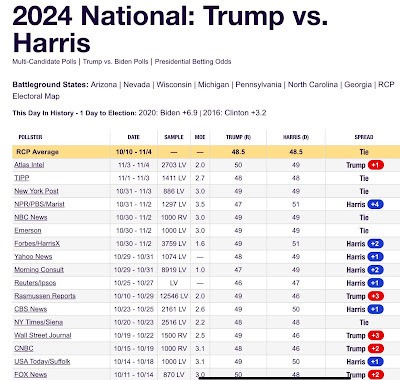
The pushback in poll-based forecasting (whether individual or aggregated) is that it may miss fundamentals on voter history and predilections, and in the last three cycles, there have been a few polling pundits who have used polling aggregates and their presumably deeper understanding of fundamentals to make judgments on who will win the election. Two are the best known are 538.com, a site that used to be part of the New York Times but is now owned by ABC, and Nate Silver's personal assessment, and leading into the election, here were their assessments for the election:
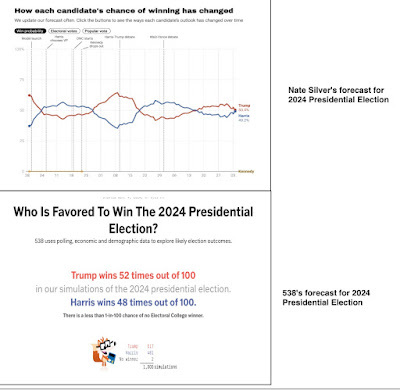
Both arrive at their estimates using Monte Carlo simulations, based upon data fed into the system. Note that polls, aggregated polls and poll judgment calls have run into problems in the last decade, some of which may be insurmountable. The first is the advent of smartphones (replacing land lines) and call screening allows callers to not answer some call, and polls have had to struggle with the consequences for sampling bias. The second is that a segment of the population has become tough, if not impossible, to poll, sometimes lying to pollsters, and to the extent that they are more likely to be for one side of the political divide, there will be systematic error in polls that will not average out, and those errors feed into polling judgments.
With poll-based forecasts being less reliable and trusted, a vacuum opened up leading into the 2024 elections, and political markets have stepped into the gap. While it has always been possible to bet on elections, either in Las Vegas or through UK-based betting sites like Betfair, they are odd-driven, opaque and restricted. In contrast, Polymarket opened markets on US election outcomes (president, senate, by state, etc.), and through much of 2024, it has given watchers a measure of what investors in that market thought about who would win the election. In the graph below, you can see the Polymarket prices for a "Trump win" and a "Harris win" in the months leading into the election:
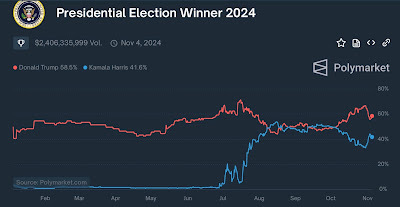
Note that until July, it was Joe Biden who was the democratic nominee for president, and the only portion of the graph that is relevant is the section starting in late July, when Kamala Harris became the nominee. Mid-year, Polymarket was joined by Kalshi, structured very similarly, with slightly different rules on trading and transactions costs, and that market's assessment of who would win the market is below:
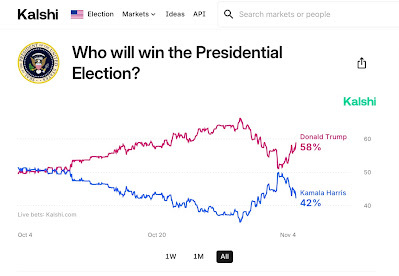
Since both markets existed in tandem for the months leading into the election, there were intriguing questions that emerged. The first is that at almost every point in time, in the months that they have co-existed, the prices for a Trump or Harris win on the two pricing platforms were different, with the prices on Kalshi generally running a little lower than on Polymarket for a Trump win.
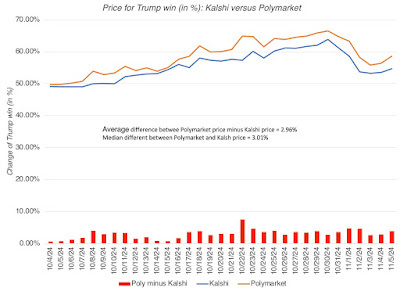
In theory, this looks like an arbitrage opportunity, where you could buy the Trump win on the cheaper market and sell it on the more expensive one, but the transactions costs (1-2% in both markets) would have made them tough to pull off.The second is that within each market, there were a proliferation of contracts covering the same outcome, trading at different prices. For instance, on Polymarket, you could buy a Trump win contract for one price, a a Republican win contract at a slightly higher price, leading into just last week, but that difference could just reflect concerns on mortality.Do the actual results vindicate political markets? At least on this election, the answer is nominally yes, since the political markets attached a higher probability for a decisive victory for Trump in the electoral college than did the poll aggregators or judgments. However, political markets did not expect Trump to win the popular vote, which he may end up doing (some states are still counting), and that can be taken as evidence that markets can be surprised sometimes. In the weeks leading into the election, there were two dimensions on which political markets varied from the polls and aggregators. On the plus side, the political markets were more dynamic, reflecting in real time, responses to events like the debates, interviews and endorsements; Polymarket's odds of a Trump win dropped by almost 10% after the debate. On the minus side, political markets were much more volatile than the polls, with swings driven sometimes by large trades; the Wall Street Journal highlighted one trader who put almost $30 million into the market on the Trump win, pushing up the price.
The Wisdom of Crowds
That trust in crowd judgments in guiding our actions is not restricted to politics. In an earlier part of this post, I talked about going to the movies, and it is indicative of the times we live in that my movie choice was made, not by reading movie reviews on the newspaper, but by movie ratings on Rotten Tomatoes. Once the movie was done, the restaurant choice I made was determined by Yelp reviews, and without boring you further, you can see this pattern unfold as you think about how you choose the products you buy on Amazon or even the services (plumbing, electrical, landscaping) that you go with, as a consumer. On a less personal and larger scale, the block chains that underlie Bitcoin transactions represent a crowd sourcing of the checking process (performed by institutions like banks conventionally), and you can argue that trusting social media to deliver you information is essentially crowd-sourcing your news.
With these examples, you can see one of the dangers of crowd judgments, and that is that in all the crowds described above (Rotten Tomatoes, Yelp, Amazon product reviews and social media), there is no cost to entry, or to offer an opinion, and that can dilute the power of the judgments. In every one of these sites, you can game the system to give high ratings to awful movies and terrible restaurants, and social media news can be filled with distortions. With markets, we introduce an entry fee to those who want to join the crowd in the form of price, and demand more money to amplify those views. In the words of Nassim Taleb, opinionated people with no skin in the game can make outlandish predictions, often with no accountability. If you don't believe me, watch the parade of experts and market gurus on any financial television channel, and notice how they are allowed to conveniently gloss over their own forecasts and predictions from earlier periods. In contrast, no matter what you think about the experience or motivations of traders on a market, they have to put money behind their views.
When you use the price in a market as an assessment of the likelihood of an event, which is what you are implicitly doing when you trust Polymarket or Kashi prices as predictors of election winners, you are, in effect, trusting the crowd (albeit a selective one of those who trade on these markets) to be closer to the right outcome than polling experts or opinion leaders. When market price based forecasts are offered as alternatives to expert forecasts, the push back that you get is that experts have a deeper knowledge of what is being predicted. So, why do we trust and attach weight to the prices that investors assess for something? There are three reasons:
Information aggregation: One of the almost magical aspects of well-functioning markets is how pieces of information possessed by individual traders about whatever is being traded get aggregated, delivering a composite price that is effectively a reflection of all of the information. Real time adjustments to news: While experts (rightfully) take their time to absorb new information and reflect that information in their assessments, markets do not have the luxury of waiting. Consequently, markets react in real time, often in the moment, to events as they unfold, and studies that look at that reaction find that they often not only beat experts to the punch but deliver better assessments. Law of large numbers: It is true that individual traders in a markets can make mistakes, often big ones, in their assessments of value, and can sometimes also let their preconceptions and biases drive their trading. To the extent that these mistakes and biases can lie on both sides, they will average out, allowing the "right' price to emerge from several wrong judgments.There is also a strand of research that is developing on the forecasting abilities of experts versus amateurs and it is not favorable for the former. Phil Tetlock, co-author of the book on super forecasting, chronicles the dismal record of expert forecasts, and argues that the best forecasts come from foxes (knows many things, but not in depth) and not hedgehogs (with deep expertise in the discipline). To the extent that a market is filled with amateurs, with very different knowledge and skill sets, Tetlock's work can be viewed as being supportive of market-based forecasts.
The Madness of Crowds
Well before we had Rotten Tomatoes and Twitter were conceived, we had financial markets, and not surprisingly, much of the most interesting research on crowd behavior has come from looking at those markets.. Our experience there is that while markets allow for information aggregation and consensus judgments that are almost magical in their timeliness and assessment quality, they are also capable of making mistakes, sometimes monumental ones. One of my favorite books is Extraordinary Popular Delusions and the Madness of Markets, published in 1841, and it chronicles how market mistakes form and grow, using the South Sea Bubble and the Tulip Bulb Craze as illustrative examples. To those who believe that markets have somehow evolved since then to avoid these mistakes, behavioral finance provides the counter, which is that the behavioral quirks that gave rise to those bubble are still present, and may actually be amplified by technology and large platforms. The falsehood that was born in a pub in the South Sea bubble often looks weeks to work its way into market prices, but the same falsehood on a large social media platform today could affect prices almost instantaneously.
Without making this a treatise on behavioral finance, here are some of the problems that can lead markets off course, and make prices poor predictors of outcomes:
Noise drowns out information: In finance, we use noise as a term to capture all of the stories and influences that should have no effect on value, but that can still affect prices. While noise exists in even the best-functioning markets, there is enough information in those markets to offset the noise effect, and bring prices back into sync with value. However, if noise is the dominant force in a market, it can drown out information, causing prices to delink from information. Momentum versus Fundamentals: On a related note, it is worth remembering that the strongest force in markets is momentum, where price movements are driven more by price movements in past periods, than by fundamentals. While in a well-functioning market, that momentum will be checked by bargain hunters (if the price is pushed too low) or short sellers (if it is pushed too high), a market where one or the other of these players is either rare or non-existent can see momentum run rampant. It is one reason that I think that markets that restrict short selling, often labeling it as speculation, are creating the condition for market madness.Participant bias: While markets require skin in the game from traders, that requires money, and that biases markets against people with little or no money. In political markets, for instance, it could be argued that the traders on Polymarket and Kalshi represent a subset of the population (younger, better off) that may differ from the voting population. Market Manipulation: The history of financial markets also includes clear cases where markets have been manipulated, to deliver profits to the manipulators. That problem becomes worse in markets with limited liquidity, where big trades can move prices, and where market insiders have access to data that outsiders do not. Illiquidity: All of the problems listed above become greater in a market where liquidity is light, since a large trade, whether motivated by noise, momentum or manipulation, will move prices more. Feedback loop: There are times where market prices can affect the fundamentals, and through them, the value of what is being traded. With publicly traded companies, a higher stock price, for instance, may allow the companies to issue shares at these higher prices, to finance investments and acquisitions. With the political markets, this feedback loop manifested itself in my social media feeds, where I often saw the Polymarket or Kashi charts being used by candidates to convince potential voters that they were winning (to get them to jump on the bandwagon) or losing (to get people to give them money).Political markets are young, attract a subset of participants, and have limited liquidity (though it did improve over the course of the months), and there were clearly times in the weeks leading in to the election, where crowd madness overwhelmed crowd wisdom. On a optimistic note, these markets are not going away, and it is almost certain that there will be more traders in these markets in the next go-around and that some of the frictions will decrease.To "crowd" or not to "crowd"
I am convinced that in making our choices as consumers and citizens, we will be facing the choice between market-based assessments and expert assessment on more and more dimensions of our life. Thus, our weather forecasts may no longer come from meteorologists, but from a weather market where weather traders will tell us what tomorrow's temperature will be or how much snow will be delivered by a snow storm. As we face these choices, there will be two camps about whether market prices should be trusted. One, rooted in the wisdom of markets, will push us to accept more crowd-sourcing and crowd-judgments, and the other, building on market madness, will point to all the things that markets can get wrong.
While I do believe that, in balance, the wisdom will offset the madness in most markets, there are places where I will stay wary, as a user of market prices. Put simply, rather than view this as an either/or choice, consider using both a market pricing, if available, and a professional assessment. In the context of my discipline, which is valuation, I use both market assessment of country default risk, in the form of sovereign CDS spreads, and sovereign ratings, from the ratings agencies. The latter have more knowledge and expertise, but they are also slow to react to changes on the ground, and I am glad that I have market prices to fill in that gap. If you are planning to trade on these markets, I would hope you will heed my admonition from this post, where I argued that if you are buying or selling something that has no cash flows, you can only trade, not value, it. In the context of political markets, the price that you are paying is a function of probabilities of outcomes and your capacity to make money in the market will come from you being able to assess those probabilities better than the rest of the market.
There is another use for these political market securities that you may want to consider. To the extent that you feel emotionally invested in one candidate winning, and you don't have much faith in your probability assessments, you may want to consider buying shares in the other candidate. That way, no matter what the outcome, you will have a partially offsetting benefit; a win for your candidate will make you happy, but you will lose some money on your political market bet, and a loss for your candidate may be emotionally devastating, but you may be able to soothe your pain with a financial windfall.
YouTube Video
Political Market Links
PolymarketKalshiBook LinksExtraordinary Popular Delusions and the Madness of MarketsConclave (Robert Harris)October 1, 2024
Just do it! Brand Name Lessons from Nike'sTroubles!
I have spent the last week reading "Shoe Dog", Phil Knight's memoir of how a runner on the Oregon University track team built one of the great shoe companies in the world, in Nike. In addition to its entertainment value, and it is a fun book to read, I read it for two storylines. The first is the time, effort and grit that it took to build a business, in a world where risk capital was more difficult to access than it has been in this century, and in a business where scaling up posed significant challenges. The second is the building of a brand name, with a mix of happy accidents (from the naming of the company to the creation of the swoosh as the company's symbol to its choice of slogan), good timing and great merchandising all playing a role in creating one of the great brand names in apparel and footwear. The latter assessment led a more general consideration of what constitutes a brand name, what makes a brand name valuable and what causes brand name values to deplete and disappear. Of course, since my attention was drawn to Nike in the first place, because of a change at the top the company and talk of brand name malaise, I tried my hand at valuing Nike in 2024, along the way.
Brand Name - What is it?
The broadest definition of a brand name is that it is recognized (by employees, consumers and the market) and remembered, either because of familiarity (because of brand name longevity) or association (with advertising or a celebrity). That definition, though, is not particularly useful since remembering or recognizing a brand, by itself, tells you nothing about its value. After all, almost everyone has heard or recognizes AT&T as a brand/corporate name, but as someone who is a cell service and internet customer of AT&T, I can assure you that neither of those choices were driven by brand name. The essence of brand name value is that the recognition or remembrance of a brand name changes how people behave in its presence. With customers, brand name recognition can manifest itself in buying choices (affecting revenues and revenue growth) or willingness to pay a higher price (higher profit margins). With capital providers, it may allow for lower funding costs, with equity investors pricing equity higher and lenders accepting lower interest rates and/or fewer lending covenants. For the moment, this may seem abstract and subjective, but in the next section, we will flesh out brand name effects on operating metrics and value more explicitly.
Corporate, Product and Personal Brand Names
Brand names can attach to entire companies, to particular products or brands, or even to personnel and people. With a company like Coca Cola, it is the corporate brand name that has the most power, but the soft drink beverages marketed by the company (Coca Cola, Fanta, Sprite, Dasani etc.) each have their own brand names. With companies like Unilever, the corporate brand name takes a back seat to the brands names of the dozens of products controlled by the company, which include Dove (soap), Axe (deodorant), Hellman's (mayonnaise) and Close-up (toothpaste), just to name a few. There are clearly cases of people with significant brand name value, in sports (Ohtani in baseball, Messi in soccer, Kohli in cricket) and entertainment (Taylor Swift, Beyonce), with a spill over to the entities that attach themselves to these people. In fact, a critical component of Nike's brand name was put in place in 1984, when the company signed on Michael Jordan, in his rookie season as a basketball player, and reaped benefits as he became the sport's biggest star over the next decade.
Brand names and other Competitive Advantages
One reason that brand name discussions often lose their focus is that companies are quick to bundle a host of competitive advantages, each of which may be valuable, in the brand name grouping. The table below, where I have loosely borrowed from Morningstar and Michael Porter is one way to think about both the types and sustainability of competitive advantages:
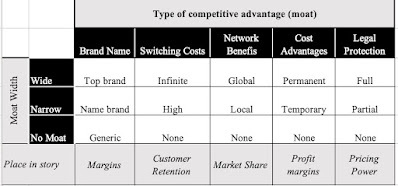
Companies like Walmart and Aramco have significant competitive advantages, but I don't think brand name is on the top five list. Walmart's strengths come from immense economies of scale and bargaining power with suppliers, and Aramco's value derives from massive oil reserves, with far lower costs of extraction, than any of its competitors. Google and Facebook control the advertising business, because they have huge networking benefits, i.e., they become more attractive destinations for advertisers as they get bigger, explaining why they were so quick to change their corporate names, and why it has had so little effect on value. The pharmaceutical companies have some brand name value, but a bigger portion of their value added comes from the protection against competition they get from owning patents. While this may seem like splitting hairs, since all competitive advantages find their way into the bottom line (higher earnings or lower risk), a company that mistakes where its competitive advantages come from risks losing those advantages.
Brand Name Value
At the risk of drawing backlash from marketing experts and brand name consultants, I will start with my "narrow" definition of brand name. In arriving at this definition, I will fall back on a structure where I connect the value of a business to key drivers, and look at how brand name will affect these drivers:
Put simply, brand name value can show up in almost every input, with a more recognizable (and respected) brand name leading to more sales (higher revenues and revenue growth), more pricing power (higher margins), and perhaps even less reinvestment and less risk (lower costs of capital and failure risk). That said, the strongest impact of brand name is on pricing power, with brand name in its purest form allowing it's owner to charge a higher price for a product or service than a competitor could charge for an identical offering. To illustrate, I walked over to my neighborhood pharmacy, and compared the prices of an over-the-counter pain killer (acetaminophen), in its branded form (Tylenol) and its generic version (CVS) :
The ingredients, in case you are wondering, are exactly the same, leading to the interesting question, more psychological than financial, of why anyone would pay an extra $2.50 for a product with no differentiating features. If you are wondering how this plays out at the business level, the operating margins of pharmaceutical companies that own the "brand names" are significantly higher than the brand names of companies that make just the generic substitutes.
The Tylenol example also serves to illustrate when it is easiest to value brand name, i.e., when it is the only competitive advantage, and when it will become difficult to do, i.e., when it has many competitive advantages. It is for that reason that valuing brand name is easier to do at a beverage or cereal company, such as Coca Cola or Kellogg's, where there is little to differentiate across products other than brand name, and you can attribute the higher margins almost entirely to brand name. It is at the basis for my valuation of Coca Cola's brand name in the picture below, where I value the company with its current operating margin:
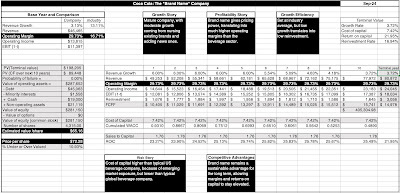 Coca Cola valuation
Note that while the company comes in as slightly overvalued, it is still given a value of $281.15 billion, with much of that value coming from its pre-tax operating margin of 29.73%. We estimate the value of Coca Cola's brand name in two steps, first comparing to a weighted average margin off 16.75% for soft-drink beverage companies, where many of the largest companies are themselves branded (Pepsi, Dr. Pepper etc.), albeit with less pricing power than Coca Coal and then comparing to the median operating margin of 6.92%, skewed towards smaller and generic beverage companies listed globally:
Coca Cola valuation
Coca Cola valuation
Note that while the company comes in as slightly overvalued, it is still given a value of $281.15 billion, with much of that value coming from its pre-tax operating margin of 29.73%. We estimate the value of Coca Cola's brand name in two steps, first comparing to a weighted average margin off 16.75% for soft-drink beverage companies, where many of the largest companies are themselves branded (Pepsi, Dr. Pepper etc.), albeit with less pricing power than Coca Coal and then comparing to the median operating margin of 6.92%, skewed towards smaller and generic beverage companies listed globally:
Coca Cola valuation
This is undoubtedly simplistic, since it assumes that the brand name value shows up entirely in the margin, and it likely understates the value of Coca Cola's brand name. That said, valuing Coca Cola at the median beverage company margin yields a value of $51 billion, suggesting that 82% of the company's intrinsic value comes from its brand name. Comparing to other beverage company and valuing at the weighted average operating margin still yields a differential brand value of $131.4 billion for Coca Cola, indicating that having a premium brand name has significant value.
Brand names become more difficult to isolate and value, when a company has multiple competitive advantages, since the higher margins or growth or returns on capital will reflect the composite effect of all of the advantages. With companies like Apple, where brand name is a factor, as is a proprietary operating system, a superior styling and a unique app ecosystem, the higher margin can be attributed to a multitude of factors, making it more difficult, perhaps even impossible, to isolate the brand name value. When valuing Birkenstock, at the time of its IPO, I wrestled with this problem, and with the help of a series of assumptions along the way, did find a way to break the value of the four intangibles that I saw in the company: a world-recognized brand name, a quality management team, free celebrity advertising and the buzz created by Margot Robbie wearing pink Birkenstock in the Barbie movie.
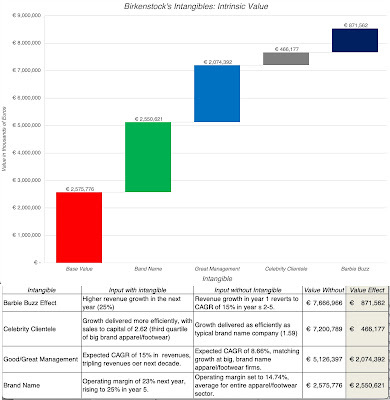 Download Birkenstock valuation at the time of IPO
Download Birkenstock valuation at the time of IPO
The pricing premium effect of brand name also becomes an effective device to strip companies that hold on to the delusion that their brand name values have value, long after they have lost their shine. If a company has margins that trail that of other companies in its industry grouping, it has lost brand name bragging rights (and value), and it is time to either accept that reality or rebrand to acquire pricing power again. Applying this test, you will find that nine out of ten companies that claim to have brand values have really nothing to show for that claim.
Nike, in my view, falls somewhere between the two extremes. It is not as pure a brand play as Coca Cola, since athletic footwear, in particular, has physical differentiation that may lead some to prefer one brand over another. At the same time, it is not as complex as Apple, insofar as even a Nike aficionado can find a relatively close substitute in another brand. To measure how Nike's brand name has played out in its operating metrics, we compared the company's operating margins to the weighted operating margin of the two businesses (two thirds footwear and one third apparel) that Nike has operated in for much of the last two decades:
 Other than 2023, Nike has consistently earned a higher operating margin (1.5% to 3% higher) than the rest of the industry, and since much of this industry is composed of brand name companies, it would suggest that Nike has a premium brand name, not surprisingly. If you are a Nike-pessimist, though, the drop off in the margin differential in the last five years is troubling, but almost all of that drop can be attributed to the company's troubles in 2023. Clearly, the company is taking the decline seriously, bringing back a Nike employee of long standing in Elliott Hill to replace John Donahoe, who cut his teeth in tech companies (ServiceNow, eBay and PayPal). I valued Nike, using its compounded annual growth rate and average operating margin over three period - 2014-2108, 2019-2023 and just the last twelve months:
Other than 2023, Nike has consistently earned a higher operating margin (1.5% to 3% higher) than the rest of the industry, and since much of this industry is composed of brand name companies, it would suggest that Nike has a premium brand name, not surprisingly. If you are a Nike-pessimist, though, the drop off in the margin differential in the last five years is troubling, but almost all of that drop can be attributed to the company's troubles in 2023. Clearly, the company is taking the decline seriously, bringing back a Nike employee of long standing in Elliott Hill to replace John Donahoe, who cut his teeth in tech companies (ServiceNow, eBay and PayPal). I valued Nike, using its compounded annual growth rate and average operating margin over three period - 2014-2108, 2019-2023 and just the last twelve months:
 Nike valuation
You can see why Nike acted swiftly to change its CEO, since its value will dip substantially, if its growth stays down and margins do not bounce back. At the $71 stock price that the stock was trading at, just six weeks ago, the investing odds would have been in your favor, but the bounce back in the stock price to $88, after the new CEO hire, suggests that the market is pricing in the expectation that the company will bounce back to higher growth and better margins.
Nike valuation
You can see why Nike acted swiftly to change its CEO, since its value will dip substantially, if its growth stays down and margins do not bounce back. At the $71 stock price that the stock was trading at, just six weeks ago, the investing odds would have been in your favor, but the bounce back in the stock price to $88, after the new CEO hire, suggests that the market is pricing in the expectation that the company will bounce back to higher growth and better margins.Brand Name Creation
Brand name does add value, if it gives the company that owns it pricing power, but how does a company end up with a valuable brand name? There are facile answers and they include longevity, with long-lived companies having more recognizable brand names, and advertising, where more spending is assumed to result in a more valuable brand name. To see why I attach the "facile" prefix to these answers, consider again the example of AT&T, a company that has been around for more than a century and remains one of the ten largest spenders on advertising in the United States. None of that spending has translated into a significant brand name value, thought there may other benefits that the company accrues.
I am sure that someone who immerses themselves in in this topic, perhaps in marketing and advertising, may be able to provide a deeper answer, but here is what I see as ingredients that go into developing a valuable brand name:
Attachment to an emotional factor/need: As marketing has recognized through the ages, the key to a powerful brand name is a tie to a human emotion. Rational or not, consumers may reach for a branded product, because they associate the product with freedom, reliability, happiness, patriotism or aspiration, if that association exists in their minds. The challenge, of course, is to find an emotion that attaches well to your product, either because of its history or its make-up, but the association, once made, can be powerful and long-lasting.Celebrity connection: Earlier, we talked about personal brand names, and argued that Nike benefited from its association with Michael Jordan, in building its brand name. In fact, Apple (in its streaming service) and Major League Soccer benefited mightily from Lionel Messi playing Inter Miami, with the former adding hundreds of thousands of subscribers to it soccer streaming service, and the latter increasing attendance in stadiums around the country. Here again, there are perils, since attaching a brand name to a person also exposes the company to the failings and foibles of that person, as Nike found out in its associations with both Tiger Woods and Colin Kaepernick.Fortuitous events/ choices: There is a third factor that is not covered in most brand name management classes, and for good reason, and that is the effect of luck. In an alternate universe, Phil Knight might have stayed with Dimension Six, his initial choice for the company name, picked a different symbol than the swoosh (for which Nike paid $35 to the designer) and even a different slogan ( than the "Just do it" picked by the advertising team), and the end result could have been very different.Advertising: While there may be little or no link between overall advertising spending and brand name, it is undeniable that there are ads that catch people's attention and alter perceptions of a product. I was an Apple user already in 1984, when it ran its famous 1984 ad during the Super Bowl, setting itself apart from the PC makers, and while that ad yielded little monetary benefit to Apple in the immediate aftermath, it contributed to creating the brand name that now allows the company to charge $1600 for a new smart phone. Nike has had its share of iconic commercials, and I still remember this Nike ad, with Michael Jordan, from 1997, showing how long the shelf life can be for a great ad.If asked to advice a company that was intent on creating a brand name, my suggestion would be to start with a product or service that is differentiated from the competition, and to give the brand name time to build around that differentiation. That may require sacrifices on scaling up (accepting less growth to preserve the product differential), a higher cost structure (if it is a quality difference) and perhaps even more reinvestment, but trade offs are inherent to almost everything of value in business. If the expected costs of building a brand name exceed its benefits, though, it may be worth asking whether brand name is the competitive advantage that the company should be aspiring for, since there are other competitive advantages that can add as much or much more value in the business the company operates in.
Brand Name Destruction
The benefit of building a strong brand name is that it remains one of the most sustainable competitive advantages in business, with the advantages often lasting decades. However, even brand names eventually lose their luster, but the reasons they do so vary:
Aging brand/consumer base: In my posts and book on corporate life cycle, I talk about how and why companies age, and how aging is inevitable. The same can be said of brand names, since even the most highly regarded brand names eventually age, and no matter how much managers try to resurrect them, they never recover their mojo. When valuing Kraft Heinz in 2015, when the most venerable name in value investing (Warren Buffett) teamed up with one of the shrewdest players in private equity (3G Capital) to buy the company because it was under valued, I wondered whether the reason the market was turning down on the company was because the portion of the population that were drawn to the company's products (fifty seven types of ketchup, all of which taste bad, and cheese that stays liquid through a nuclear winter) to be tasty was getting smaller and older. In hindsight, it is clear that Kraft Heinz will not reclaim its former glory, because its products and customer base have aged.Benign neglect: Brand names may provide sustainable competitive advantages, but only if they are cared for and maintained. There are legendary brand names that have been neglected, treated as cash cows with no new investment or sprucing up needed, and have faded in value. Quaker Oats, a longstanding mainstay of the US cereal business, not only allowed itself to pushed to the sidelines by aggressive cereal companies, but failed to take advantage of the rise in demand for oatmeal as a heart-healthy substitute. Cultural changes: There are products and services that have lost their allure over time, because the cultural mores or social norms of the consumers have changed. If you binge watch Mad Men, the television series about advertising in the 1960s, you should not be surprised to see ads for products and services that you would now view in a very different light. Changing tastes: There are some businesses, where the demand for products is transient and fad-driven, and new brands replace old ones, as tastes shift. This has generally been the case with apparel retail in the United States, with the Gap's reign at the top lasting about a decade, with newer and cooler retail brands like Abercrombie and Fitch and Tommy Hilfiger replacing them, and then were themselves being displaced by H&M and Uniqlo. Toxic connections: A brand name that is built up over time can sometimes very quickly fall back to earth, if the company or its personnel bring toxic connections. Abercrombie and Fitch, for instance, which became a hot destination for the young in the first decade of this century, found its brand name devastated by accusations of racism and sexism in its ranks. Brand overreach: There are cases where a company with a valuable brand name may dilute or even destroy that brand name by overreaching, and putting it on products that cut agains the brand name narrative. A good argument can be made that Disney, usually masterful at managing its brands, diluted the value of both its Avengers and Star Wars franchises by rushing headlong into the streaming business, with new series.While all of these forces can cause a once valuable brand name to lose its value, it is worth noting that there are companies that have redeemed brand name value, sometimes by remaking the product or service, sometimes by repackaging it and sometimes by repositioning it. Crocs, whose brand name soared in the 2000s, but crashed by the end of the decade, repackaged itself around celebrity endorsements to become a successful brand again. Lego, a venerable brand name in the toy business, sold off its theme parks, and refocused attention on its core product, while redirecting its offerings to adults. In general, though, reincarnating a brand becomes easier for niche brands than for mass market ones, for product brands than for company brands, and for younger brands than for older ones. I believe that 2023 was a wake up call for Nike, as it awoke multiple disruptions. First, in the post-COVID years, Nike moved from store sales to digital sales, with Nike Digital, accounting for almost 43% of revenues in 2022. While that shift does reflect a change in consumer preferences towards shopping online, there is a question of whether bypassing shoe stores, which over the decades have contributed to the Nike brand, by highlighting their most iconic shoes, has undercut the brand. Second, while the footwear business has been more resistant to fads than the apparel business, Nike;'s mass market strategy of being all things to all people is exposing it to disruption. The company is losing market share, especially among younger customers, to newcomers in the space like On and Hoka, and among runners (Nike's original core market) to older companies like New Balance that have rediscovered their mojo. Third, in an age where celebrities come with problems, and politics divides us on even the most trivial of issues, Nike's celebrity-driven advertising campaigns may hurt more than help the company. In short, Nike's new CEO has his work cut out for him!YouTube Video
LinksCoca Cola - Intrinsic Valuation in September 2024Nike - Intrinsic Valuation in September 2024Operating Metrics by Industry group, with distributions (Quartiles and Median)
September 20, 2024
Fed up with Fed Talk? Fact-checking Central Banking Fairy Tales!
The big story on Wednesday, September 18, was that the Federal Reserve’s open market committee finally got around to “cutting rates”, and doing so by more than expected. This action, much debated and discussed during all of 2024, was greeted as "big" news, and market prognosticators argued that it was a harbinger of market moves, both in interest rates and stock prices. The market seemed to initially be disappointed in the action, dropping after the Fed’s announcement on Wednesday, but it did climb on Thursday. Overall, though, and this is my view, this was about as anticlimactic as a climactic event gets, akin to watching an elephant in labor deliver a mouse. As a long-time skeptic about the Fed’s (or any Central Bank’s) capacity to alter much in markets or the economy, I decided now would be as good a time as any to confront some widely held beliefs about central banking powers, and counter them with data. In particular, I want to star with the myth that central banks set interest rates, or at least the interest rates that you and I may face in our day-to-day lives, move on to the slightly lesser myth that the Fed's move lead market interest rates, then examine the signals that emanate supposedly from Fed actions, and finish off by evaluating how the Fed's actions affect stock prices.
The Fed as Rate Setter
As I drove to the grocery story on Fed Cut Wednesday, I had the radio on, and in the news at the top of the hour, I was told that the Fed had just cut interest rates, and that consumers would soon see lower rates on their mortgages and businesses on their loans. That delusion is not restricted to newscasters, since it seems to be widely held among politicians, economists and even market watchers. The truth, though, is that the Fed sets only one interest rate, the Fed Funds rate, and that none of the rates that we face in our lives, either as consumers (on mortgages, credit cards or fixed deposits) or businesses (business loans and bonds), are set by or even indexed to the Fed Funds Rate.
The place to start to dispel the “Fed sets rates” myth is with an understanding of the Fed Funds rate, an overnight intra-bank borrowing rate is one that most of us will never ever encounter in our lives. The Federal Open Market Committee (FOMC) has the power to change this rate, which it uses at irregular intervals, in response to economic, market and political developments. The table below lists the rate changes made by the Fed in this century:
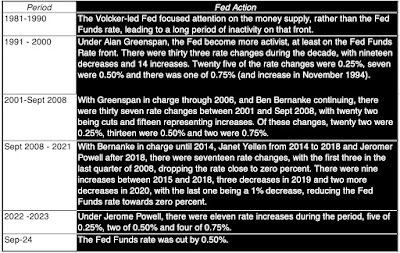
Note that while most of these changes were made at regularly scheduled meetings, a few (eleven in the last three decades) were made at emergency meetings, called in response to market crises. As you can see from this table, the Federal Reserve goes through periods of Fed Funds rate activism, interspersed with periods of inactivity. Since the Fed Funds rate is specified as a range, there are periods where the effective Fed Funds rate may go up or down, albeit within small bounds. To gain perspective on how the Fed Funds rate has been changed over time, consider the following graph, where the effective fed funds rate is shown from 1954 to 2024:
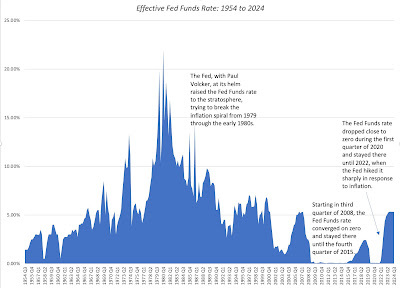 Download data
Download data
In addition to revealing how much the Fed Funds rate has varied over time, there are two periods that stand out. The first is the spike in the Fed Funds rate to more than 20% between 1979 and 1982, when Paul Volcker was Fed Chair, and represented his attempt to break the cycle of high inflation that had entrapped the US economy. The second was the drop in the Fed Funds rate to close to zero percent, first after the 2008 crisis and then again after the COVID shock in the first quarter of 2020. In fact, coming into 2022, the Fed had kept the Fed Funds rates at or near zero for most of the previous 14 years, making the surge in rates in 2022, in response to inflation, shock therapy for markets unused to a rate-raising Fed.
While the Federal Open Market Committee controls the Fed Funds rate, there are a whole host of rates set by buyer and sellers in bond markets. These rates are dynamic and volatile, and you can see them play out in the movements of US treasury rates (with the 3-month and 10-year rates highlighted) and in corporate bond rates (with the Baa corporate bond rate shown).
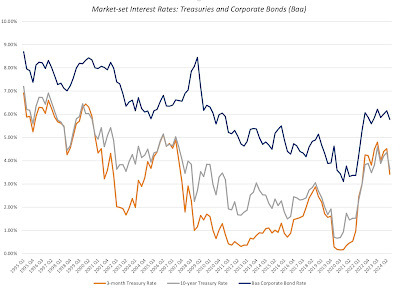 Download data
Download data
There is a final set of rates, set by institutions, and sometimes indexed to market-set rates, and these are the rates that consumers are most likely to confront in their day-to-day lives. They include mortgage rates, set by lenders, credit card rates, specified by the credit card issuers, and fixed deposit rates on safety deposits at banks. They are not as dynamic as market-set rates, but they change more often than the Fed Funds rate.
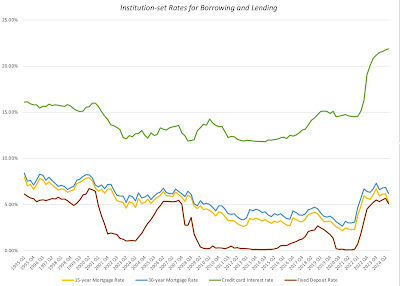 Download data
Download data
There are undoubtedly other interest rates you will encounter, as a consumer or a business, either in the course of borrowing money or investing it, but all of these rates will fall into one of three buckets - market-set interest rates, rates indexed to market-set rates and institutionally-set rates. None of these rates are set by the Federal Reserve, thus rendering the "Fed sets interest rates" as myth.
The Fed as Rate Leader
Even if you accept that the Fed does not set the interest rates that we face as consumers and businesses, you may still believe that the Fed influences these rates with changes it makes to the Fed Funds rate. Thus, you are arguing that a rise (fall) in the Fed Funds rate can trigger subsequent rises (falls) in both market-set and institution-set rates. At least superficially, this hypothesis is backed up in the chart below, where I brings all the rates together into one figure:
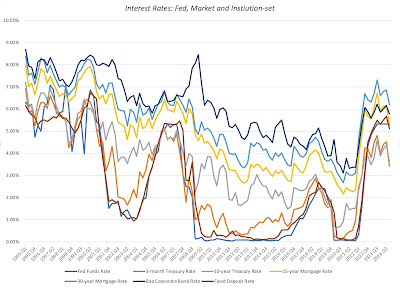 Download data
Download data
As you can see, the rates all seem to move in sync, though market-set rates move more than institution-set rates, which, in turn, are volatile than the Fed Funds rate. The reason that this is a superficial test is because these rates all move contemporaneously, and there is nothing in this graph that supports the notion that it is the Fed that is leading the change. In fact, it is entirely possible, perhaps even plausible, that the Fed's actions on the Fed Funds rate are in response to changes in market rates, rather than the other way around.
To test whether changes in the Fed Funds rate are a precursor for shifts in market interest rates, I ran a simple (perhaps even simplistic) test. I looked at the 249 quarters that compose the 1962- 2024 time period, breaking down each quarter into whether the effective Fed Funds rate increased, decreased or remained unchanged during the quarter. I followed up by looking at the change in the 3-month and 10-year US treasury rates in the following quarter:
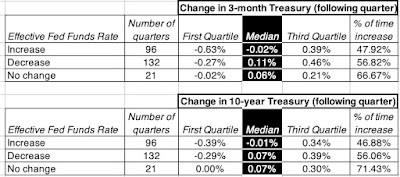 Download data
Download data
Looking at the key distributional metrics (the first quartile, the median, the third quartile), it seems undeniable that the "Fed as leader" hypothesis falls apart. In fact, in the quarters after the Fed Funds rate increases, US treasury rates (short and long term) are more likely to decrease than increase, and the median change in rates is negative. In contrast, in the periods after the Fed Fund decreases, treasury rates are more likely to increase than decrease, and post small median increases. Expanding this assessment to the interest rates that consumers face, and in particular mortgage rates at which they borrow and fixed deposit rates at which they can invest, the results are just as stark.
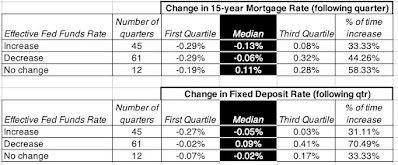 Download data
Download data
In the quarter after the Fed Funds rate increase, mortgage rates and fixed deposit rates are more likely to fall than rise, with the median change in the 15-year mortgage rate being -0.13% and the median change in the fixed deposit rate at -0.05%. In the quarter after the Fed Funds rate decreases, the mortgage rate does drop, but by less than it did during the Fed rate raising quarters. In short, those of us expecting our mortgage rates to decline in the next few months, just because the Fed lowered rates on Wednesday, are being set up for disappointment. If you are wondering why I did not check to see what credit card interest rates do in response to Fed Funds rate changes, even a casual perusal of those rates suggests that they are unmoored from any market numbers. You may still be skeptical about my argument that the Fed is more follower than leader, when it comes to interest rates. After all, you may say, how else can you explain why interest rates remained low for the last decades, other than the Fed? The answer is recognizing that market-set rates ultimately are composed of two elements: an expected inflation rate and an expected real interest rate, reflecting real economic growth. In the graph below, which I have used multiple times in prior posts, I compute an intrinsic risk free rate by just adding inflation rate and real GDP growth each year:
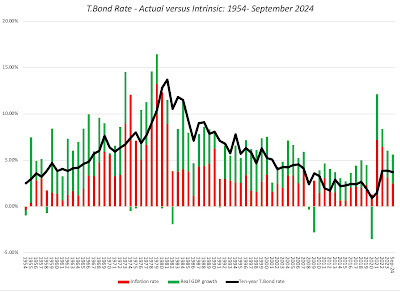 Download data
Download dataInterest rates were low in the last decade primarily because inflation stayed low (the lowest inflation decade in a century) and real growth was anemic. Interest rates rose in 2022, because inflation made a come back, and the Fed scrambled to catch up to markets, and most interesting, interest are down this year, because inflation is down and real growth has dropped. As you can see, in September 2024, the intrinsic riskfree rate is still higher than the 10-year treasury bond rate, suggesting that there will be no precipitous drop in interest rates in the coming months.
The Fed as Signalman
If you are willing to accept that the Fed does not set rates, and that it does not lead the market on interest rates, you may still argue that Fed rate changes convey information to markets, leading them to reprice bonds and stocks. That argument is built on the fact that the Fed has access to data about the economy that the rest of us don't have, and that its actions tell you implicitly what it is seeing in that data.
It is undeniable that the Federal Reserve, with its twelve regional districts acting as outposts, collects information about the economy that become an input into its decision making. Thus, the argument that Fed actions send signals to the markets has basis, but signaling arguments come with a caveat, which is that the signals can be tough to gauge. In particular, there are two major macroeconomic dimensions on which the Fed collects data, with the first being real economic growth (how robust it is, and whether there are changes happening) and inflation (how high it is and whether it too is changing). The Fed's major signaling device remains the changes in the Fed Funds rate, and it is worth pondering what the signal the Fed is sending when it raises or lowers the Fed Funds rate. On the inflation front, an increase or decrease in the Fed Funds rate can be viewed as a signal that the Fed sees inflationary pressures picking up, with an increase, or declining, with a decrease. On the economic growth front, an increase or decrease in the Fed Funds rate, can be viewed as a signal that the Fed sees the economy growing too fast, with an increase, or slowing down too much, with a decrease. These signals get amplified with the size of the cut, with larger cuts representing bigger signals.
Viewed through this mix, you can see that there are two contrary reads of the Fed Funds rate cut of 50 basis points on Wednesdays. If you are an optimist, you could take the action to mean that the Fed is finally convinced that inflation has been vanquished, and that lower inflation is here to stay. If you are a pessimist, the fact that it was a fifty basis point decrease, rather than the expected twenty five basis points, can be construed as a sign that the Fed is seeing more worrying signs of an economic slowdown than have shown up in the public data on employment and growth. There is of course the cynical third perspective, which is that the Fed rate cut has little to do with inflation and real growth, and more to do with an election that is less than fifty days away. In sum, signaling stories are alluring, and you will hear them in the coming days, from all sides of the spectrum (optimists, pessimists and cynics), but the truth lies in the middle, where this rate cut is good news, bad news and no news at the same time, albeit to different groups.
The Fed as Equity Market Whisperer
It is entirely possible that you are with me so far, in my arguments that the Fed's capacity to influence the interest rates that matter is limited, but you may still hold on to the belief that the Fed's actions have consequences for stock returns. In fact, Wall Street has its share of investing mantras, including "Don't fight the Fed", where the implicit argument is that the direction of the stock market can be altered by Fed actions.
There is some basis for this argument, and especially during market crises, where timely actions by the Fed may alter market mood and momentum. During the COVID crisis, I complimented the Fed for playing its cards right, especially so towards the end of March 2023, when markets were melting down, and argued that one reason that market came back as quickly as they did was because of the Fed. That said, it was not so much the 100 basis point drop in the Fed Funds rate that turned the tide, but the accompanying message that the Federal Reserve would become a backstop for lenders to companies that were rocked by the COVID shutdown, and were teetering on the edge. While the Fed did not have to commit much in capital to back up this pledge, that decision seemed to provide enough reassurance to lenders and prevent a host of bankruptcies at the time.
If you remove the Fed's role in crisis, and focus on the effects of just its actions on the Fed Funds rate, the effect of the Fed on equity market becomes murkier. I extended the analysis that I did with interest rates to stocks, and looked at the change in the S&P 500 in the quarter after Fed Funds rates were increased, decreased or left unchanged:
 Download dataThe S&P 500 did slightly better in quarters after the Fed Funds rate decreased than when the rate increased, but reserved its best performance for quarters after those where there was no change in the Fed Funds rate. At the risk of disagreeing with much of conventional wisdom, is it possible that the less activity there is on the part of the Fed, the better stocks do? I think so, and stock markets will be better served with fewer interviews and speeches from members of the FOMC and less political grandstanding (from senators, congresspeople and presidential candidates) on what the Federal Reserve should or should not do.
Download dataThe S&P 500 did slightly better in quarters after the Fed Funds rate decreased than when the rate increased, but reserved its best performance for quarters after those where there was no change in the Fed Funds rate. At the risk of disagreeing with much of conventional wisdom, is it possible that the less activity there is on the part of the Fed, the better stocks do? I think so, and stock markets will be better served with fewer interviews and speeches from members of the FOMC and less political grandstanding (from senators, congresspeople and presidential candidates) on what the Federal Reserve should or should not do.The Fed as Chanticleer
If the Fed does not set rates, is not a interest rate driver, sends out murky signals about the economy and has little effect on how stocks move, you are probably wondering why we have central banks in the first place. To answer, I am going to digress, and repeat an ancient story about Chanticleer, a rooster that was anointed the ruler of the farmyard that he lived in, because the other barnyard animals believed that it was his crowing every morning that caused the sun to rise, and that without him, they would be destined for a lifetime of darkness. That belief came from the undeniable fact that every morning, Chanticleer's crowing coincided with sun rise and daylight. The story now takes a dark turn, when one day, Chanticleer sleeps in and the sun rises anyway, revealing his absence of power, and he loses his place at the top of the barnyard hierarchy.
The Fed (and every other central bank) in my view is like Chanticleer, with investors endowing it with powers to set interest rates and drive stock prices, since the Fed's actions and market movements seem synchronized. As with Chanticleer, the truth is that the Fed is acting in response to changes in markets rather than driving those actions, and it is thus more follower than leader. That said, there is the very real possibility that the Fed may start to believe its own hype, and that hubristic central bankers may decide that they set rates and drive stock markets, rather than the other way around. That would be disastrous, since the power of the Fed comes from the perception that it has power, and an over reach can lay bare the truth.
Conclusion
I know that this post cuts against the grain, since the notion that the Fed has superpowers has only become stronger over the last two decades. Pushed to explain why interest rates were at historic lows for much of the last decade, the response you often heard was "the Fed did it". Active investors, when asked why active investing had its worst decade in history, losing out to index funds and to passive investors, pointed fingers the Fed. Market timers, who had built their reputations around using metrics like the Shiller PE, defended their failure to call market moves in the last fifteen years, by pointing to the Fed. Economists who argued that inverted yield curves were a surefire predictor of recessions blamed the Fed for the absence of a recession, after years of two years plus of the phenomena.
I believe that it is time for us to put the Fed delusion to rest. It has distracted us from talking about things that truly matter, which include growing government debt, inflation, growth and how globalization may be feeding into risk, and allowed us to believe that central bankers have the power to rescue us from whatever mistakes we may be making. I am a realist, though, and I am afraid that the Fed Delusion has destroyed enough investing brain cells, that those who holding on to the delusion cannot let go. I am already hearing talk among this group about what the FOMC may or may not do at its next meeting (and the meeting after that), and what this may mean for markets, restarting the Fed Watch. The insanity of it all!
YouTube Video
Data
Fed Funds Rates, Treasury Rates and Other Market Interest rates - HistoricalIntrinsic treasury bond rates
September 9, 2024
Dealing with Aging: Updating the Intel, Walgreens and Starbucks Stories!
A few weeks ago, I posted on the corporate life cycle, the subject of my latest book. I argued that the corporate life cycle can explain what happens to companies as they age, and why they have to adapt to aging with their actions and choices. In parallel, I also noted that investors have to change the way they value and price companies, to reflect where they are in the life cycle, and how different investment philosophies lead you to concentrated picks in different phases of the life cycle. In the closing section, I contended that managing and investing in companies becomes most difficult when companies enter the last phases of their life cycles, with revenues stagnating or even declining and margins under pressure. While consultants, bankers and even some investors push companies to reinvent themselves, and find growth again, the truth is that for most companies, the best pathway, when facing aging, is to accept decline, shrink and even shut down. In this post, I will look at three high profile companies, Intel, Starbucks and Walgreens, that have seen market turmoil and management change, and examine what the options are for the future.
Setting the stage
The three companies that I picked for this post on decline present very different portraits. Intel was a tech superstar not that long ago, a company founded by Gordon Moore, Robert Noyce and Arthur Rock in 1968, whose computer chips have helped create the tech revolution. Walgreens is an American institution, founded in Chicago in 1901, and after its merger with Alliance Boots in 2014, one of the largest pharmacy chains in the country. Finally, Starbucks, which was born in 1971 as a coffee bean wholesaler in Pike Place Market in Seattle, was converted into a coffee shop chain by Howard Schultz, and to the dismay of Italians, has redefined espresso drinks around the world. While they are in very different businesses, what they share in common is that over the recent year or two, they have all not only lost favor in financial markets, but have also seen their business models come under threat, with their operating metrics (revenue growth, margins) reflecting that threat.
The Market turns
With hundreds of stocks listed and traded in the market, why am I paying attention to these three? First, the companies are familiar names. Our personal computes are often Intel-chip powered, there is a Walgreen's a few blocks from my home, and all of us have a Starbucks around the corner from where we live and work. Second, they have all been in the news in the last few weeks, with Starbucks getting a new CEO, Walgreens announcing that they will be shutting down hundreds of their stores and Intel coming up in the Nvidia conversation, often as a contrast. Third, they have all seen the market turn against them, though Starbucks has had a comeback after its new CEO hire.
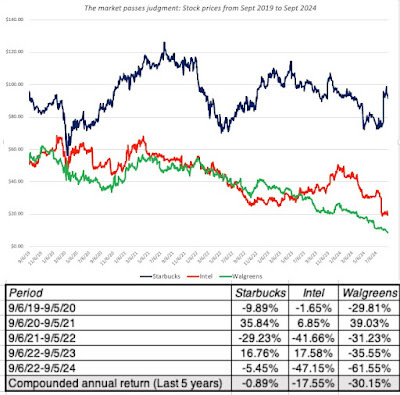 None of the three stocks has been a winner over the last five years, but the decline in Intel and Walgreen's has been precipitous, especially int he last three years. That decline has drawn the usual suspects. On the one hand are the knee-jerk contrarians, to whom a drop of this magnitude is always an opportunity to buy, and on the other are the apocalyptists, where large price declines almost always end in demise. I am not a fan of either extreme, but it is undeniable that both groups will be right on some stocks, and wrong on others, and the only way to tell the difference is to look at each of the companies in more depth.
None of the three stocks has been a winner over the last five years, but the decline in Intel and Walgreen's has been precipitous, especially int he last three years. That decline has drawn the usual suspects. On the one hand are the knee-jerk contrarians, to whom a drop of this magnitude is always an opportunity to buy, and on the other are the apocalyptists, where large price declines almost always end in demise. I am not a fan of either extreme, but it is undeniable that both groups will be right on some stocks, and wrong on others, and the only way to tell the difference is to look at each of the companies in more depth.A Tech Star Stumbles: Intel’s Endgame
In my book on corporate life cycles, I noted that even superstar companies age and lose their luster, and Intel could be a case study. The company is fifty six years old (it was founded in 1968) and the question is whether its best years are behind it. In fact, the company's growth in the 1990s to reach the peak of the semiconductor business is the stuff of case studies, and it stayed at the top for longer than most of its tech contemporaries. Intel's CEO for its glory years was Andy Grove, who joined the company on its date of incorporation in 1968, and stayed on to become chairman and CEO before stepping down in 1998. He argued for constant experimentation and adaptive leadership, and the title of his book, "Only the Paranoid Survive", captured his management ethos.
To get a measure of why Intel's fortunes have changed in the last decade, it is worth looking at its key operating metrics - revenues, gross income and operating income - over time:
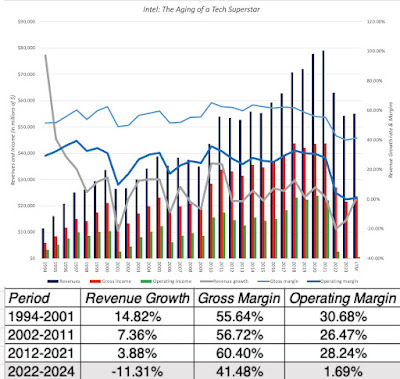
As you can see in this graph, Intel's current troubles did not occur overnight, and its change over time is almost textbook corporate life cycle. As Intel has scaled up as a company, its revenue growth has slackened and its growth rate in the last decade (2012-21) is more reflective of a mature company than a growth company. That said, it was a healthy and profitable company during that decade, with solid unit economics (as reflected in its high gross margin) and profitability (its operating margin was higher in the last decade than in prior periods). In the last three years, though, the bottom seems to fallen out of Intel's business model, as revenues have shrunk and margins have collapsed. The market has responded accordingly, and Intel, which stood at the top of the semiconductor business, in terms of market capitalization for almost three decades, has dropped off the list of top ten semiconductor companies in 2024, in market cap terms:

Intel's troubles cannot be blamed on industry-wide issues, since Intel's decline has occurred at the same time (2022-2024) as the cumulative market capitalization of semiconductor companies has risen, and one of its peer group (Nvidia) has carried the market to new heights.
Before you blame the management of Intel for not trying hard enough to stop its decline, it is worth noting that if anything, they have been trying too hard. In the last few years, Intel has invested massive amounts into its chip manufacturing business (Intel Foundry), trying to compete with TSMC, and almost as much into its new generation of AI chips, hoping to claim market share of the fastest growing markets for AI chips from Nvidia. In fact, a benign assessment of Intel would be that they are making the right moves, but that these moves will take time to pay off, and that the market is being impatient. A not-so-benign reading is that the market does not believe that Intel can compete effectively against either TSMC (on chip manufacture) or Nvidia (on AI chip design), and that the money spent on both endeavors will be wasted. The latter group is clearly winning out in markets, at the moment, but as I will argue in the next section, the question of whether Intel is a good investment at its current depressed price may rest in which group you think has right on its side.
Drugstore Blues: Walgreen Wobbles
From humble beginnings in Chicago, Walgreen has grown to become a key part of the US health care system as a dispenser of pharmacy drugs and products. The company went public in 1927, and in the century since, the company has acquired the characteristics of a mature company, with growth spurts along the way. Its acquisition of a significant stake in Alliance Boots gave it a larger global presence, albeit at a high price, with the acquisition costing $15.3 billion. Again, to understand, Walgreen's current position, we looked at the company's operating history by looking revenue growth and profit margins over time:
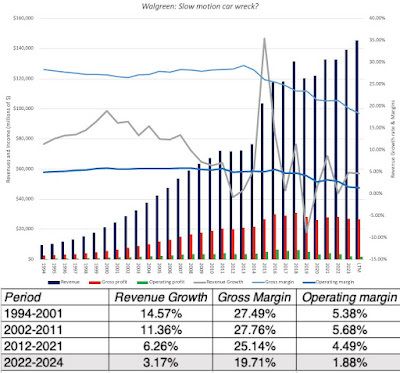
After double digit growth from 1994 to 2011, the company has struggled to grow in a business, with daunting unit economics and slim operating margins, and the last three years have only seen things worsen on all fronts, with revenue growth down, and margins slipping further, below the Maginot line; with an 1.88% operating margin, it is impossible to generate enough to cover interest expenses and taxes, thus triggering distress.
While management decisions have clearly contributed to the problems, it is also true that the pharmacy business, which forms Walgreen's core, has deteriorated over the last two years, and that can be seen by comparing its market performance to CVS, its highest profile competitor.
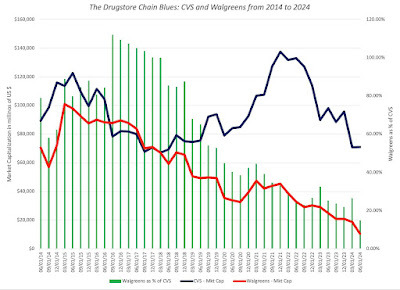
As you can see, both CVS and Walgreens have seen their market capitalizations drop since mid-2022, but the decline in Walgreens has been far more precipitous than at CVS; Walgreens whose market cap exceeded that of CVS in 2016 currently has one tenth of the market capitalization of CVS. In response to the slowing down of the pharmacy business, Walgreens has tried to find a pathway back to growth, albeit with acquired growth. A new CEO, Roz Brewer, was brought into the company in 2021, from Sam's Club, and wagered the company's future on acquisitions, buying four companies in 2021, with a majority stake in Village MD, a chain of doctor practices and clinics, representing the biggest one. That acquisition, which cost Walgreens $5.2 billion, has been more cash drain than flow, and in 2024, Ms. Brewer was replaced as CEO by Tim Wentworth, and Village MD scaled back its growth plans.Venti no more The Humbling of Starbucks
On my last visit to Italy, I did make frequent stops at local cafes, to get my espresso shots, and I can say with confidence that none of them had a caramel macchiato or an iced brown sugar oatmilk shaken espresso on the menu. Much as we make fun of the myriad offerings at Starbucks, it is undeniable that the company has found a way into the daily lives of many people, whose day cannot begin without their favorite Starbucks drink in hand. Early on, Starbucks eased the process by opening more and more stores, often within blocks of each other, and more recently, by offering online ordering and pick up, with rewards supercharging the process. Howard Schultz, who nursed the company from a single store front in Seattle to an ubiquitous presence across America, was CEO of the company from 1986, and while he retired from the position in 2000, he returned from 2008 to 2017, to restore the company after the financial crisis, and again from 2022 to 2023, as an interim CEO to bridge the gap between the retirement of Kevin Johnson in 2022 and the hiring of Laxman Narasimhan in 2023. To get a measure of how Starbucks has evolved over time, I looked the revenues and margins at the company, over time:
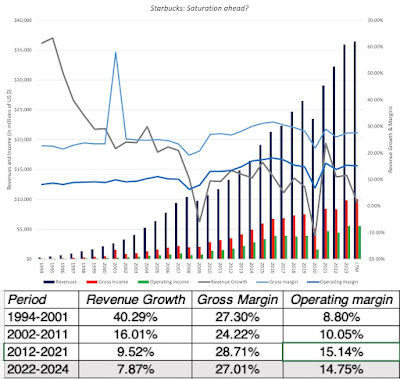
Unlike Intel and Walgreens, where the aging pattern (of slowing growth and steadying margins) is clearly visible, Starbucks is a tougher case. Revenue growth at Starbucks has slackened over time, but it has remained robust even in the most recent period (2022-2024). Profit margins have actually improved over time, and are much higher than they were in the first two decades of the company's existence. One reason for improving profitability is that the company has become more cautious about store openings, at least in the United States, and sales have increased on a per-store basis:
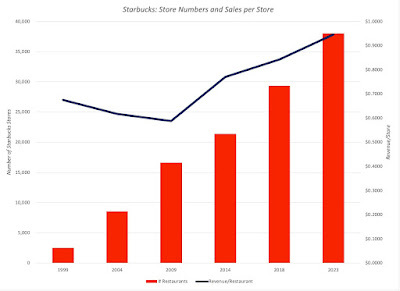
In fact, the shift towards online ordering has accelerated this trend, since there is less need for expansive store locations, if a third or more of sales come from customers ordering online, and picking up their orders. In short, these graphs suggest that it is unfair to lump Starbuck with Intel and Walgreens, since its struggles are more reflecting of a growth company facing middle age.
So, why the market angst? The first is that there are some Starbucks investors who continue to hold on to the hope that the company will be able to return to double digit growth, and the only pathway to get there requires that Starbucks be able to succeed in China and India. However, Starbucks has had trouble in China competing with domestic lower-priced competitors (Luckin' Coffee and others), and there are restrictions on what Starbucks can do with its joint venture with the Tata Group in India. The second problem is that the narrative for the company, that Howard Schultz sold the market on, where coffee shops become a gathering spot for friends and acquaintances, has broken down, partly because of the success of its online ordering expansion. The third problem is that inflation in product and employee costs has made its products expensive, leading to less spending even from its most loyal customers.
A Life Cycle Perspective
It is undeniable that Intel and Walgreens are in trouble, not just with markets but operationally, and Starbucks is struggling with its story line. However, they face different challenges, and perhaps different pathways going forward. To make that assessment, I will more use my corporate life cycle framework, with a special emphasis on the the choices that agin companies face, with determinants on what should drive those choices.
The Corporate Life Cycle
I won't bore you with the details, but the corporate life cycle resembles the human life cycle, with start-ups (as babies), very young companies (as toddlers), high growth companies (as teenagers) moving on to mature companies (in middle age) and old companies facing decline and demise:
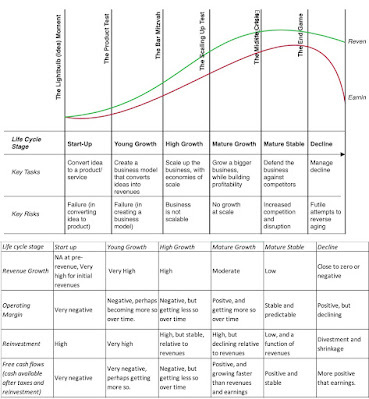
The phase of the life cycle that this post is focused on is the last one, and as we will see in the next section, it is the most difficult one to navigate, partly because shrinking as a firm is viewed as failure., and that lesson gets reinforced in business schools and books about business success. I have argued that more money is wasted by companies refusing to act their age, and much of that waste occurs in the decline phase, as companies desperately try to find their way back to their youth, and bankers and consultants egg them on.
The Choices
There is no more difficult phase of a company's life to navigate than decline, since you are often faced with unappetizing choices. Given how badly we (as human beings) face aging, it should come as no surprise that companies (which are entities still run by human beings) also fight aging, often in destructive ways. In this section, I will start with what I believe are the most destructive choices made by declining firms, move on to a middling choice (where there is a possibility of success) before examining the most constructive responses to aging.
a. Destructive
Denial: When management of a declining business is in denial about its problems, attributing the decline in revenues and profit margins to extraordinary circumstances, macro developments or bad luck, it will act accordingly, staying with existing practices on investing, financing and dividends. If that management stays in place, the truth will eventually catch up with the company, but not before more money has been sunk into a bad business that is un-investable. Desperation: Management may be aware that their business is in decline, but it may be incentivized, by money or fame, to make big bets (acquisitions, for example), with low odds, hoping for a hit. While the owners of these businesses lose much of the time, the managers who get hits become superstars (and get labeled as turnaround specialists) and increase their earning power, perhaps at other firms.Survival at any cost: In some declining businesses, top managers believe that it is corporate survival that should be given priority over corporate health, and they act accordingly. In the process, they create zombie or walking dead companies that survive, but as bad businesses that shed value over time.b. It dependsMe-too-ism: In this choice, management starts with awareness that their existing business model has run out of fuel and faces decline, but believe that a pathway exists back to health (and perhaps even growth) if they can imitate the more successful players in their peer groups. Consequently, their investments will be directed towards the markets or products where success has been found (albeit by others), and financing and cash return policies will follow. Many firms adopt this strategy find themselves at a disadvantage, since they are late to the party, and the winners often have moats that are difficult to broach or a head start that cannot be overcome. For a few firms, imitation does provide a respite and at least a temporary return to mature growth, if not high growth.c. ConstructiveAcceptance: Some firms accept that their business is in decline and that reversing that decline is either impossible to do or will cost too much capital. They follow up by divesting poor-performing assets, spinning off or splitting off their better-performing businesses, paying down debt and returning more cash to the owners. If they can, they settle in on being smaller firms that can continue to operate in subparts of their old business, where they can still create value, and if this is not possible, they will liquidate and go out of business.Renewals and Revamps: In a renewal (where a company spruces up its existing products to appeal to a larger market) or a revamp (where it adds to its products and service offering to make them more appealing), the hope is that the market is large enough to allow for a return to steady growth and profitability. To pull this off, managers have to be clear eyed about what they offer customers, and recognize that they cannot abandon or neglect their existing customer base in their zeal to find new ones.Rebirths: This is perhaps every declining company's dream, where you can find a new market or product that will reset where the company in the life cycle. This pitch is powered by case studies of companies that have succeeded in pulling off this feat (Apple with the iPhone, Microsoft with Azure), but these successes are rare and difficult to replicate. While one can point to common features including visionary management and organic growth (where the new business is built within the company rather than acquired), there is a strong element of luck even in the success stories.The Determinants
Clearly, not all declining companies adopt the same pathway, when faced with decline, and more companies, in my view, take the destructive paths than the constructive one. To understand why and how declining companies choose to do what they do, you may want to consider the following:
In the figure below, I summarize the discussion from this section, looking at both the choices that companies can make, and the determinants:
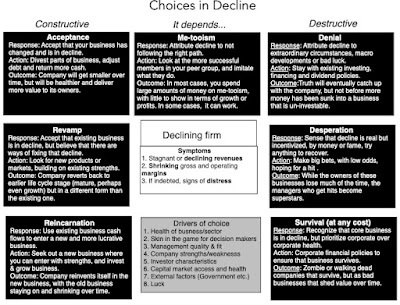
With this framework in place, I am going to try to make my best judgments (which you may disagree with) on what the three companies highlighted in this post should do, and how they will play out for me, as an investor:
Intel: It is my view that Intel's problems stem largely from too much me-too-ism and aspiring for growth levels that they cannot reach. On both Ai and the chip manufacturing business, Intel is going up against competition (Nvidia on AI and TSMC on manufacturing) that has a clear lead and significant competitive advantages. However, the market is large enough and has sufficient growth for Intel to find a place in both, but not as a leader. For a company that is used to being at the top of the leaderboard, that will be a step down, but less ambition and more focus is what fits the company, at this stage in the life cycle. It is likely that even if it succeeds, Intel will revert to middle age, not high growth, but that should still make it a good investment. In the table below, you can see that at its prevailing stock price of $18.89 (on Sept 8, 2024), all you need is a reversion back towards more normal margins for the price to be justified: Download Intel valuationWith 3% growth and 25% operating margins, Intel's value per share is already at $23.70 and any success that the company is in the AI chip market or benefits it derives from the CHIPs act, from federal largesse, are icing on the cake. I do believe that Intel will derive some payoff from both, and I am buying Intel, to twin with what is left of my Nvidia investment from six years ago.Walgreens: For Walgreens, the options are dwindling, as its core businesses face challenges. That said, and even with its store closures, Walgreens remains the second largest drugstore chain in the United States, after CVS. Shrinking its presence to its most productive stores and shedding the rest may be the pathway to survival, but the company will have to figure out a way to bring down its debt proportionately. There is the risk that a macro slowdown or a capital market shock, causing default risk and spreads to widen, could wipe out equity investors. With all of that said, and building in a risk of failure to the assessment, I estimated the value per share under different growth and profitability assumptions:
Download Intel valuationWith 3% growth and 25% operating margins, Intel's value per share is already at $23.70 and any success that the company is in the AI chip market or benefits it derives from the CHIPs act, from federal largesse, are icing on the cake. I do believe that Intel will derive some payoff from both, and I am buying Intel, to twin with what is left of my Nvidia investment from six years ago.Walgreens: For Walgreens, the options are dwindling, as its core businesses face challenges. That said, and even with its store closures, Walgreens remains the second largest drugstore chain in the United States, after CVS. Shrinking its presence to its most productive stores and shedding the rest may be the pathway to survival, but the company will have to figure out a way to bring down its debt proportionately. There is the risk that a macro slowdown or a capital market shock, causing default risk and spreads to widen, could wipe out equity investors. With all of that said, and building in a risk of failure to the assessment, I estimated the value per share under different growth and profitability assumptions:
 Download Walgreens valuationThe valuation pivots entirely on whether operating margins improve to historical levels, with margins of 4% or higher translating into values per share that exceed the stock price. I believe that the pharmacy business is ripe for disruption, and that the margins will not revert back to pre-2021 levels, making Walgreens a "no go" for me.
Download Walgreens valuationThe valuation pivots entirely on whether operating margins improve to historical levels, with margins of 4% or higher translating into values per share that exceed the stock price. I believe that the pharmacy business is ripe for disruption, and that the margins will not revert back to pre-2021 levels, making Walgreens a "no go" for me.Starbucks: Starbucks is the outlier among the three companies, insofar as its revenue growth is still robust and it remains a money-making firm. Its biggest problem is that it has lost its story line, and it needs to rediscover a narrative that can not only give investors a sense of where it is going, but will redirect how it is managed. As I noted in my post on corporate life cycle, story telling requires visionaries, and in the case of Starbucks, that visionary also has to understand the logistical challenges of running coffee shops. I do not know enough about Brian Niccol to determine whether he fits the bill. As someone who led Taco Bell and Chipotle, I think that he can get the second part (understanding restaurant logistics) nailed down, but is he a visionary? He might be, but visionary CEOs generally do not live a thousand miles from corporate headquarters, and fly corporate jets to work part time at their jobs, and Niccol has provided no sense of what he sees as the new Starbucks narrative yet. For the moment, thought, there seems to be euphoria in the market that change is coming, though no one seems clear on what that change is, and the stock price has almost fully recovered from its swoon to reach $91 on September 8, 2024. That price is well above any value per share that I can get for the company, even assuming that they go back to historic norms:
 I must be missing some of the Starbucks magic that investors are seeing, since there is no combination of historical growth/margins that gets me close to the current stock price. In fact, the only way my value per share reaches current pricing levels is if I see the company maintaining its revenue growth rates from 2002-2011, while delivering the much higher operating margins that it earned between 2012-2021. That, to me, is a bridge too far to cross.
I must be missing some of the Starbucks magic that investors are seeing, since there is no combination of historical growth/margins that gets me close to the current stock price. In fact, the only way my value per share reaches current pricing levels is if I see the company maintaining its revenue growth rates from 2002-2011, while delivering the much higher operating margins that it earned between 2012-2021. That, to me, is a bridge too far to cross.The Endgame
There is a reason that so many people want to be entrepreneurs and start new businesses. Notwithstanding the high mortality rate, building a new business is exciting and, if successful, hugely rewarding. A healthy economy will encourage entrepreneurship, providing risk capital and not tilting the playing field towards established players; it remains the strongest advantage that the United States has over much of the rest of the world. However, it is also true that the measure of a healthy economy is in how it deals with declining businesses and firms. If as Joseph Schumpeter put it, capitalism is all about creative destruction, it follows that companies, which are after all legal entities that operate businesses, should fade away as the reasons for their existence fade. That is one reason I critique the entire notion of corporate sustainability (as opposed to planet sustainability), since keeping declining companies alive, and supplying them with additional capital, redirects that capital away from firms that could do far more good (for the economy and society) with that capital.
If there is a subtext to this post, it is that we need a healthier framing of corporate decline, as inevitable at all firms, at some stage in their life cycle, rather than something that should be fought. In business schools and books, we need to highlight not just the empire builders and the company saviors, i.e., CEOs who rescued failing companies and made their companies bigger, but the empire shrinkers, i.e., CEOs who are brought into declining firms, who preside over an orderly (and value adding) shrinkage or breaking of their firms. In investing, it is true that the glory gets reserved for the Mag Seven and the FANGAM stocks, companies that seem to have found the magic to keep growing even as they scale up, but we should also pay attention to companies that find their way to deliver value for shareholders in bad businesses.
YouTube Video
Links
Corporate Life Cycle (my blog post)Corporate Life Cycle (my book)Valuations
Intel in September 2024Walgreens in September 2024Starbucks in September 2024September 5, 2024
The Power of Expectations: Nvidia's Earnings and the Market Reaction!
Earnings Reports: The Components When I was first exposed to financial markets in a classroom, I was taught about information being delivered to markets, where that information is processed and converted into prices. I was fascinated by the process, an interplay of accounting, finance and psychology, and it was the subject of my doctoral thesis, on how distortions in information delivery (delays, lies, mistakes) affects stock returns. In the real world, that fascination has led me to pay attention to earnings reports, which while overplayed, remain the primary mechanism for companies to convey information about their performance and prospects to markets.
The Timing Publicly traded companies have had disclosure requirements for much of their existence, but those requirements have become formalized and more extensive over time, partly in response to investor demands for more information and partly to even the playing field between institutional and individual investors. In the aftermath of the great depression, the Securities Exchange Commission was created as part of the Securities Exchange Act, in 1934, and that act also required any company issuing securities under that act, i.e., all publicly traded firms, make annual filings (10Ks) and quarterly filings (10Qs), that would be accessible to investors. The act also specifies that these filings be made in a timely manner, with a 1946 stipulation the annual filings being made within 90 days of the fiscal year-end, and the quarterly reports within 45 calendar days of the quarter-end. With technology speeding up the filing process, a 2002 rule changed those requirements to 60 days, for annual reports, and 40 days for quarterly reports, for companies with market capitalizations exceeding $700 million. While there are some companies that test out these limits, most companies file well within these deadlines, often within a couple of weeks of the year or quarter ending, and many of them file their reports on about the same date every year. If you couple the timing regularity in company filings with the fact that almost 65% of listed companies have fiscal years that coincide with calendar years, it should come as no surprise that earnings reports tend to get bunched up at certain times of the year (mid-January, mid-April, mid-July and mid-October), creating “earnings seasons”. That said, there are quite a few companies, many of them high-profile, that preserve quirky fiscal years, and since Nvidia’s earnings report triggered this post, it is worth noting that Nvidia has a fiscal year that ends on January 31 of each year, with quarters ending on April 30, July 31 and October 31. In fact, the Nvidia earnings report on August 28 covered the second quarter of this fiscal year (which is Nvidia's 2025 fiscal year).
The Expectations Game While corporate earnings reports are delivered once a quarter, the work of anticipating what you expect these reports to contain, especially in terms of earnings per share, starts almost immediately after the previous earnings report is delivered. In fact, a significant portion of sell side equity research is dedicated to this activity, with revisions made to the expected earnings, as you get closer and closer to the next earnings report. In making their earnings judgments and revisions, analysts draw on many sources, including:The company’s history/news: With the standard caveat that the past does not guarantee future results, analysts consider a company’s historical trend lines in forecasting revenues and earnings. This can be augmented with other information that is released by the company during the course of the quarter.Peer group reporting: To the extent that the company’s peer group is affected by common factors, it is natural to consider the positive or negative the operating results from other companies in the group, that may have reported earnings ahead of your company. Other analysts’ estimates: Much as analysts claim to be independent thinkers, it is human nature to be affected by what others in the group are doing. Thus, an upward revision in earnings by one analyst, especially an influential one, can lead to revisions upwards on the part of other analysts.Macro news: While macroeconomic news (about the economy, inflation or currency exchange rates) cuts across the market, in terms of impact, some companies are more exposed to macroeconomic factors than others, and analysts will have to revisit earnings estimates in light of new information.The earnings expectations for individual companies, from sell side equity research analysts are publicly accessible, giving us a window on trend lines. Nvidia is one of the most widely followed companies in the world, and most of the seventy plus analysts who publicly follow the firm play the estimation game, leading into the earnings reports. Ahead of the most recent second quarter earnings report, the analyst consensus was that the company would report revenues of $28.42 billion for the quarter, and fully diluted earnings per share of 64 cents; in the 30 days leading into the report, the earnings estimates had drifted up mildly (about 0.1%), with the delay in the Blackwell (NVidia’s new AI chip) talked about but not expected to affect revenue growth near term. It is worth noting that not all analysts tracking the stock forecast every metric, and that there was disagreement among them, which is also captured in the range on the estimates; on earnings per share, for instance, the estimates ranged from 60 to 68 cents, and on revenues, from $26 to $30 billion. The pre-game show is not restricted to analysts and investors, and markets partake in the expectations game in two ways. Stock prices adjust up or down, as earnings expectations are revised upwards or downwards, in the weeks leading up to the earnings report. Nvidia, which traded at $104 on May 23rd, right after the company reported its results for the first quarter of 2024, had its ups and down during the quarter, hitting an all-time high of $135.58 on June 18, 2024, and a low of $92.06, on August 5, before ending at $125.61 on August 28, just ahead of the earnings report:
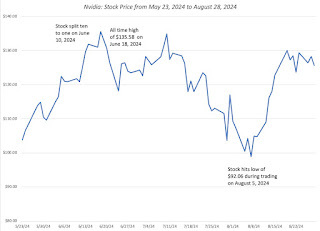
During that period, the company also split its shares, ten to one, on June 10, a week ahead of reaching its highs.
Stock volatility can also changes, depending upon disagreements among analysts about expected earnings, and the expected market reaction to earnings surprises. That effect is visible not only in observed stock price volatility, but also in the options market, as implied volatility. For Nvidia, there was clearly much more disagreement among investors about the contents of the second quarter earnings report, with implied volatility spiking in the weeks ahead of the report:
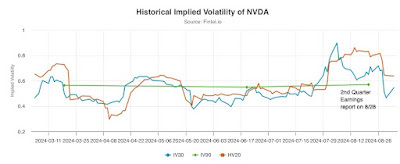 Source: Fintel
Source: Fintel
While volatility tends to increase just ahead of earnings reports, the surge in volatility ahead of the second quarter earnings for Nvidia was unusually large, a reflection of the disagreement among investors about how the earnings report would play out in the market. Put simply, even before Nvidia reported earnings on August 28, markets were indicating more unease about both the contents of the report and the market reaction to the report, than they were with prior earnings releases.
The Event Given the lead-in to earnings reports, what exactly do they contain as news? The SEC strictures that companies disclose both annual and quarterly results have been buffered by accounting requirements on what those disclosures should contain. In the United States, at least, quarterly reports contain almost all of the relevant information that is included in annual reports, and both have suffered from the disclosure bloat that I called attention to in my post on disclosure diarrhea. Nvidia’s second quarter earnings report, weighing in at 80 pages, was shorter than its annual report, which ran 96 pages, and both are less bloated than the filings of other large market-cap companies. The centerpieces of the earnings report, not surprisingly, are the financial statements, as operating numbers are compared to expectations, and Nvidia’s second quarter numbers, at least at first sight, are dazzling:
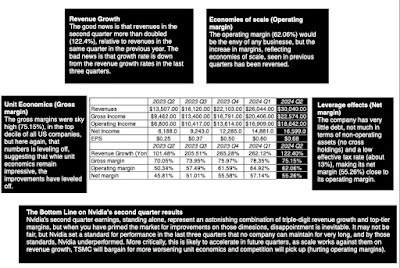
The company’s astonishing run of the last few years continues, as its revenues, powered by AI chip sales, more than doubled over the same quarter last year, and profit margins came in at stratospheric levels. The problem, though, is that the company's performance over the last three quarters, in particular, have created expectations that no company can meet. While it is just one quarter, there are clear signs of more slowing to come, as scaling will continue to push revenue growth down, the unit economics will be pressured as chip manufacturers (TSMC) push for a larger slice and operating margins will decrease, as competition increases. Over the last two decades, companies have supplemented the financial reports with guidance on key metrics, particularly revenues, margins and earnings, in future quarters. That guidance has two objectives, with the first directed at investors, with the intent of providing information, and the second at analysts, to frame expectations for the next quarter. As a company that has played the expectations game well, it should come as no surprise that Nvidia provided guidance for future quarters in its second quarter report, and here too, there were reminders that comparisons would get more challenging in future quarters, as they predicted that revenue growth rates would come back to earth, and that margins would, at best, level off or perhaps even decline. Finally, in an overlooked news story, Nvidia announced that it would had authorized $50 billion in buybacks, over an unspecified time frame. While that cash return is not surprising for a company that has became a profit machine, it is at odds with the story that some investors were pricing into the stock of a company with almost unlimited growth opportunities in an immense new market (AI). Just as Meta and Alphabet’s dividend initiations signaled that they were approaching middle age, Nvidia’s buyback announcement may be signaling that the company is entering a new phase in the life cycle, intentionally or by accident.
The Scoring The final piece of the earning release story, and the one that gets the most news attention, is the market reaction to the earnings reports. There is evidence in market history that earnings reports affect stock prices, with the direction of the effect depending on how actual earnings measure up to expectations. While there have been dozens of academic papers that focus on market reactions to earnings reports, their findings can be captured in a composite graph that classifies earnings reports into deciles, based upon the earnings surprise, defined as the difference between actual and predicted earnings:
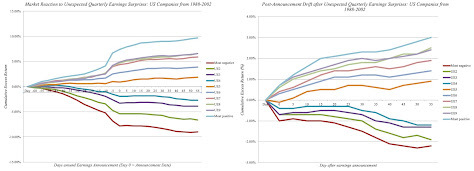
As you can see, positive surprises cause stock prices to increase, whereas negative surprises lead to price drops, on the announcement date, but there is drift both before and after surprises in the same direction. The former (prices drifting up before positive and down before negative surprises) is consistent with the notion that information about earnings surprises leaks to markets in the days before the report, but the latter (prices continuing to drift up after positive or down after negative surprises) indicates a slow-learning market that can perhaps be exploited to earn excess returns. Breaking down the findings on earnings reports, there seems to be evidence that the that the earnings surprise effect has moderated over time, perhaps because there are more pathways for information to get to markets. Nvidia is not only one of the most widely followed and talked about stocks in the market, but one that has learned to play the expectations game well, insofar as it seems to find a way to beat them consistently, as can be seen in the following table, which looks at their earnings surprises over the last 5 years:
 Nvidia Earnings Surprise (%)Barring two quarters in 2022, Nvidia has managed to beat expectations on earnings per share every quarter for the last five years. There are two interpretations of these results, and there is truth in both of them. The first is that Nvidia, as with many other technology companies, has enough discretion in both its expenditures (especially in R&D) and in its revenue recognition, that it can use it to beat what analysts expect. The second is that the speed with which the demand for AI chips has grown has surprised everyone in the space (company, analysts, investors) and that the results reflect the undershooting on forecasts. Focusing specifically on the 2025 second quarter, Nvidia beat analyst expectations, delivering earnings per share of 68 cents (above the 64 cents forecast) and revenues of $30 billion (again higher than the $28.4 billion forecast), but the percentage by which it beat expectations was smaller than in the most recent quarters. That may sound like nitpicking, but the expectations game is an insidious one, where investors move the goal posts constantly, and more so, if you have been successful in the past. On August 28, after the earnings report, Nvidia saw share prices drop by 8% and not only did that loss persist through the next trading day, the stock has continued to lose ground, and was trading at $106 at the start of trading on September 6, 2028.
Nvidia Earnings Surprise (%)Barring two quarters in 2022, Nvidia has managed to beat expectations on earnings per share every quarter for the last five years. There are two interpretations of these results, and there is truth in both of them. The first is that Nvidia, as with many other technology companies, has enough discretion in both its expenditures (especially in R&D) and in its revenue recognition, that it can use it to beat what analysts expect. The second is that the speed with which the demand for AI chips has grown has surprised everyone in the space (company, analysts, investors) and that the results reflect the undershooting on forecasts. Focusing specifically on the 2025 second quarter, Nvidia beat analyst expectations, delivering earnings per share of 68 cents (above the 64 cents forecast) and revenues of $30 billion (again higher than the $28.4 billion forecast), but the percentage by which it beat expectations was smaller than in the most recent quarters. That may sound like nitpicking, but the expectations game is an insidious one, where investors move the goal posts constantly, and more so, if you have been successful in the past. On August 28, after the earnings report, Nvidia saw share prices drop by 8% and not only did that loss persist through the next trading day, the stock has continued to lose ground, and was trading at $106 at the start of trading on September 6, 2028.Earnings Reports: Reading the Tea Leaves So what do you learn from earnings reports that may cause you to reassess what a stock is worth? The answer will depend upon whether you consider yourself more of a trader or primarily an investor. If that distinction is lost on you, I will start this section by drawing the contrast between the two approaches, and what each approach is looking for in an earnings report.
Value versus Price At the risk of revisiting a theme that I have used many times before, there are key differences in philosophy and approach between valuing an asset and pricing it.The value of an asset is determined by its fundamentals – cash flows, growth and risk, and we attempt to estimate that value by bringing in these fundamentals into a construct like discounted cash flow valuation or a DCF. Looking past the modeling and the numbers, though, the value of a business ultimately comes from the story you tell about that business, and how that story plays out in the valuation inputs.The price of an asset is set by demand and supply, and while fundamentals play a role, five decades of behavioral finance has also taught us that momentum and mood have a much greater effect in pricing, and that the most effective approach to pricing an asset is to find out what others are paying for similar assets. Thus, determining how much to pay for a stock by using a PE ratio derived from looking its peer group is pricing the stock, not valuing it.The difference between investing and trading stems from this distinction between value and price. Investing is about valuing an asset, buying it at a price less than value and hoping that the gap will close, whereas trading is almost entirely a pricing game, buying at a low price and selling at a higher one, taking advantage of momentum or mood shifts. Given the very different perspectives the two groups bring to markets, it should come as no surprise that what traders look for in an earnings report is very different from what investors see in that same earnings report.
Earnings Reports: The Trading Read If prices are driven by mood and momentum, it should come as no surprise that what traders are looking for in an earnings report are clues about how whether the prevailing mood and momentum will prevail or shift. It follows that traders tend to focus on the earnings per share surprises, since its centrality to the report makes it more likely to be a momentum-driver. In addition, traders are also swayed more by the theater around how earnings news gets delivered, as evidenced, for instance, by the negative reaction to a recent earnings report from Tesla, where Elon Musk sounded downbeat, during the earnings call. Finally, there is a significant feedback loop, in pricing, where the initial reaction to an earnings report, either online or in the after market, can affect subsequent reaction. As a trader, you may learn more about how an earnings report will play out by watching social media and market reaction to it than by poring over the financial statements. For Nvidia, the second quarter report contained good news, if good is defined as beating expectations, but the earnings beat was lower than in prior quarters. Coupled with sober guidance and a concern the stock had gone up too much and too fast, as its market cap had increased from less than half a trillion to three trillion over the course of two years, the stage was set for a mood and momentum shift, and the trading since the earnings release indicates that it has happened. Note, though, that this does not mean that something else could not cause the momentum to shift back, but before you, as an Nvidia manager or shareholder, are tempted to complain about the vagaries of momentum, recognize that for much of the last two years, no stock has benefited more from momentum than Nvidia.
The Investing Read For investors, the takeaways from earnings reports should be very different. If value comes from key value inputs (revenues growth, profitability, reinvestment and risk), and these value inputs themselves come from your company narrative, as an investor, you are looking at the earnings reports to see if there is information in them that would change your core narrative for the company. Thus, an earnings report can have a significant effect on value, if it significantly changes the growth, profitability or risk parts of your company’s story, even though the company’s bottom line (earnings per share) might have come in at expectations. Here are a few examples:A company reporting revenue growth, small or even negligible for the moment, but coming from a geography or product that has large market potential, can see its value jump as a consequence. In 2012, I reassessed the value of Facebook upwards, a few months after it had gone public and seen its stock price collapse, because its first earnings report, while disappointing in terms of the bottom line, contained indications that the company was starting to succeed in getting its platform working on smart phones, a historical weak spot for the firm.You can also have a company reporting higher than expected revenue growth accompanied by lower than anticipated profit margins, suggesting a changing business model, and thus a changed story and valuation. Earlier this year, I valued Tesla, and argued that their lower margins, while bad news standing alone, was good news if your story for Tesla was that it would emerge as a mass market automobile company, capable of selling more cars than Volkswagen and Toyota. Since the only pathway to that story is with lower-priced cars, the Tesla strategy of cutting prices was in line with that story, albeit at the expense of profit margins.A company reporting regulatory or legal actions directed against it, that make its business model more costly or more risky to operate, even though its current numbers (revenues, earnings etc.) are unscathed (so far).In short, if you are an investor, the most interesting components of the report are not in the proverbial bottom line, i.e., whether earnings per share came in below or above expectations, but in the details. Finally, as investors, you may be interested in how earnings reports change market mood, usually a trading focus, because that mood change can operate as a catalyst that causes the price-value gap to close, enriching you in the process.
The figure below summarizes this section, by first contrasting the value and pricing processes, and then looking at how earnings releases can have different meanings to different market participants.
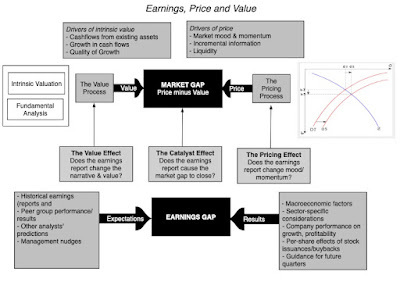
As in other aspects of the market, it should therefore come as no surprise that the same earnings report can have different consequences for different market participants, and it is also possible that what is good news for one group (traders) may be bad news for another group (investors).
Nvidia: Earnings and Value My trading skills are limited, and that I am incapable of playing the momentum game with any success. Consequently, I am not qualified to weigh in on the debate on whether the momentum shift on Nvidia is temporary or long term, but I will use the Nvidia second quarter earnings report as an opportunity to revisit my Nvidia story and to deliver a September 2024 valuation for the company. My intrinsic valuation models are parsimonious, built around revenue growth, profit margins and reinvestment, and I used the second quarter earnings report to review my story (and inputs) on each one:
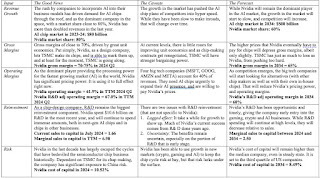 Nvidia: Valuation Inputs (Sept 2024)With these input changes in place, I revalued Nvidia at the start of September 2024, breaking its revenues, earnings and cash flows down into three businesses: an AI chip business that remains its central growth opportunity, and one in which it has a significant lead on the competition, an auto chip business where it is a small player in a small game, but one where there is potential coming from demand for more powerful chips in cars, and the rest, including its existing business in crypto and gaming, where growth and margins are solid, but unlikely to move dramatically. While traders may be disappointed with Nvidia’s earnings release, and wish it could keep its current pace going, I think it is both unrealistic and dangerous to expect it to do so. In fact, one reason that my story for Nvidia has become more expansive, relative to my assessment in June 2023, is that the speed with which AI architecture is being put in place is allowing the total market to grow at a rate far faster than I had forecast last year. In short, relative to where I was about a year ago, the last four earnings reports from the company indicate that the company can scale up more than I thought it could, has higher and more sustainable margins than I predicted and is perhaps less exposed to the cycles that the chip business has historically been victimized by. With those changes in place, my value per share for Nvidia in is about $87, still about 22% below the stock price of $106 that the stock was trading at on September 5, 2024, a significant difference but one that is far smaller than the divergence that I noted last year.
Nvidia: Valuation Inputs (Sept 2024)With these input changes in place, I revalued Nvidia at the start of September 2024, breaking its revenues, earnings and cash flows down into three businesses: an AI chip business that remains its central growth opportunity, and one in which it has a significant lead on the competition, an auto chip business where it is a small player in a small game, but one where there is potential coming from demand for more powerful chips in cars, and the rest, including its existing business in crypto and gaming, where growth and margins are solid, but unlikely to move dramatically. While traders may be disappointed with Nvidia’s earnings release, and wish it could keep its current pace going, I think it is both unrealistic and dangerous to expect it to do so. In fact, one reason that my story for Nvidia has become more expansive, relative to my assessment in June 2023, is that the speed with which AI architecture is being put in place is allowing the total market to grow at a rate far faster than I had forecast last year. In short, relative to where I was about a year ago, the last four earnings reports from the company indicate that the company can scale up more than I thought it could, has higher and more sustainable margins than I predicted and is perhaps less exposed to the cycles that the chip business has historically been victimized by. With those changes in place, my value per share for Nvidia in is about $87, still about 22% below the stock price of $106 that the stock was trading at on September 5, 2024, a significant difference but one that is far smaller than the divergence that I noted last year.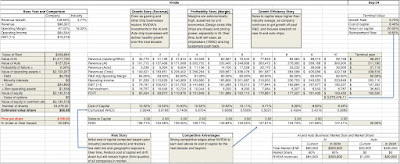 Download spreadsheet
Download spreadsheetAs always, the normal caveats apply. The first is that I value companies for myself, and while my valuations drive my decisions to buy or sell stocks, they should not determine your choices. That is why my Nvidia valuation spreadsheet is available not just for download, but for modification, to allow you to tell your own story for Nvidia, yielding a different value and decision. The second is that this is a tool for investors, not traders, and if you are playing the trading game, you will have to reframe the analysis and think in terms of mood and momentum. Looking back, I am at peace with the decision made in the summer of 2023 to shed half my Nvidia shares, and hold on to half. While I left money on the table, with the half that I sold, I have been richly compensated for holding on to the other half. I am going to count that as a win and move on!
YouTube Video
LinksNvidia 10 Q (for 2nd Quarter 2025)Nvidia Valuation (updated on September 5, 2024)
August 28, 2024
Beat your Bot: Building your moat against AI
It seems like a lifetime has passed since artificial intelligence (AI) became the market's biggest mover, but Open AI introduced the world to ChatGPT on November 30, 2022. While ChatGPT itself represented a low-tech variation of AI, it opened the door to AI not only as a business driver, but one that had the potential to change the way we work and live. In a post on June 30, 2023, I looked at the AI effect on businesses, arguing that it had the potential to ferment revolutionary change, but that it would also create a few big winners, a whole host of wannabes, and many losers, as its disruption worked its way through the economy. In this post, I would like to explore that disruption effect, but this time at a personal level, as we are warned that we risk being displaced by our AI counterparts. I want to focus on that question, trying to find the middle ground between irrational terror, where AI consigns us all to redundancy, and foolish denial, where we dismiss it as a fad.
The Damodaran Bot I was in the eleventh week of teaching my 2024 spring semester classes at Stern, when Vasant Dhar, who teaches a range of classes from machine learning to data science at NYU's Stern School (where I teach as well), and has forgotten more about AI than I will ever know, called me. He mentioned that he had developed a Damodaran Bot, and explained that it was an AI creation, which had read every blog post that I had ever written, watched every webcast that I had ever posted and reviewed every valuation that I had made public. Since almost everything that I have ever written or done is in the public domain, in my blog, YouTube videos and webpage, that effectively meant that my bot was better informed than I was about my own work, since its memory is perfect and mine is definitely not. He also went on to tell me that the Bot was ready for a trial run, ready to to value companies, and see how those valuations measured up against valuations done by the best students in my class.The results of the contest are still being tabulated, and I am not sure what results I would like to see, since either of the end outcomes would reflect poorly on me. If the Bot's valuations work really well, i.e., it values companies as well, or better, than the students in my class, that is about as strong a signal that I am facing obsolescence, that I can get. If the Bot's valuations work really badly, that would be a reflection that I have failed as a teacher, since the entire rationale for my postings and public valuations is to teach people how to do valuation.
Gauging the threat In the months since I was made aware of the Damodaran Bot, I have thought in general terms about what AI will be able to do as well or better than we can, and the areas where it might have trouble. Ultimately, AI is the coming together of two forces that have become more powerful over the last few decades. The first is increasing (and cheaper) computing power, often coming into smaller and smaller packages; our phones are now computationally more powerful than the very first personal computers. The second is the cumulation of data, both quantitative and qualitative, especially with social media accelerating personal data sharing. As an AI novice, it is entirely possible that I am not gauging the threat correctly, but there are three dimensions on which I see the AI playing out (well or badly).Mechanical/Formulaic vs Intuitive/Adaptable: Well before ChatGPT broke into the public consciousness, IBM's Deep Blue was making a splash playing chess, and beating some of the world's greatest chess players. Deep Blue's strength at chess came from the fact that it had access to every chess game ever played (data) and the computing power to evaluate 200 million chess positions per second, putting even the most brilliant human chess player at a disadvantage. In contrast, AI has struggled more with automated driving, not because driving is mechanically complicated, but because there are human drivers on the surface roads, behaving in unpredictable ways. While AI is making progress on making intuitive leaps, and being adaptable, it will always struggle more on those tasks than on the purely mechanical ones.Rules-based vs Principle-based: Expanding the mechanical/intuitive divide, AI will be better positioned to work smoothly in rules-based disciplines, and will be at a disadvantage in principle-based disciplines. Using valuation to illustrate my point, accounting and legal valuations are mostly rule-based, with the rules sometimes coming from theory and practice, and sometimes from rule writers drawing arbitrary lines in the sand. AI can not only replicate those valuations, but can do so at no cost and with a much closer adherence to the rules. In contrast, financial valuations done right, are built around principles, requiring judgment calls and analytical choices on the part of appraisers, on how these principles get applied, and should be more difficult to replace with AI.Biased vs Open minded: There is a third dimension on which we can look at how easy or difficult it will be for AI to replace humans and that is in the human capacity to bring bias into decisions and analyses, while claiming to be objective and unbiased. Using appraisal valuation to illustrate, it is worth remembering that clients often come to appraisers, especially in legal or accounting settings, with specific views about what they would like to see in their valuations, and want affirmation of those views from their appraisers, rather than the objective truth. A business person valuing his or her business, ahead of a divorce, where half the estimated value of that business has to be paid out to a soon-to-be ex-spouse, wants a low value estimate, not a high one, and much as the appraiser of the business will claim objectivity, that bias will find its way into the numbers and value. It is true that you can build AI systems to replicate this bias, but it will be much more difficult to convince those systems that the appraisals that emerge are unbiased.Bringing this down to the personal, the threat to your job or profession, from AI, will be greater if your job is mostly mechanical, rule-based and objective, and less if it is intuitive, principle-based and open to biases.
Responding to AI While AI, at least in its current form, may be unable to replace you at your job, the truth is that AI will get better and more powerful over time, and it will learn more from watching what you do. So, what can we do to make it more difficult to be outsourced by machines or replaced by AI? It is a question that I have thought about for three decades, as machines have become more powerful, and data more ubiquitous, and while I don't have all of the answers, I have four thoughts.
Generalist vs Specialist: In the last century, we have seen a push towards specialization in almost every discipline. In medicine, the general practitioner has become the oddity, as specialists abound to treat individual organs and diseases, and in finance, there are specialists in sub-areas that are so esoteric that no one outside those areas can even comprehend the intricacies of what they do. In the process, there are fewer and fewer people who are comfortable operating outside their domains, and humanity has lost something of value. It is the point I made in 2016, after a visit to Florence, where like hundreds of thousands of tourists before me, I marveled at the beauty of the Duomo, one of the largest free-standing domes in the world, at the time of its construction.

The Duomo built by Filippo Brunelleschi, an artist who taught himself enough engineering and construction to be able to build the dome, and he was carrying on a tradition of others during that period whose interests and knowledge spanned multiple disciplines. In a post right after the visit, I argued that the world needed more Renaissance men (and women), individuals who can operate across multiple disciplines, and with AI looming as a threat, I feel even more strongly about this need. A Leonardo Da Vinci Bot may be able to match the master in one of his many dimensions (painter, sculptor, scientist), but can it span all of them? I don't think so!Practice bounded story telling: Starting about a decade ago, I drew attention to a contradiction at the heart of valuation practice, where as access to data and more powerful models has increased, in the last few decades, the quality of valuations has actually become worse. I argued that one reason for that depletion in quality is that valuations have become much too mechanical, exercises in financial modeling, rather than assessments of business quality and value. I went on to make the case that good valuations are bridges between stories and numbers, and wrote a book on the topic.
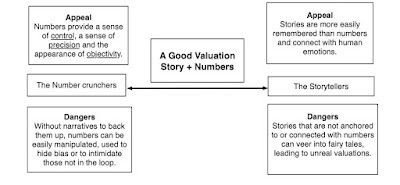
At the time of the book's publication, I wrote a post on why I think stories make valuations richer and better, and with the AI threat looming, connecting stories to numbers comes with a bonus. If your valuation is all about extrapolating historical data on a spreadsheet, AI can do it quicker, and with far fewer errors than you can. If, however, your valuation is built around a business story, where you have considered the soft data (management quality, the barriers to entry), AI will have a tougher time replicating what you do. Reasoning muscle: I have never been good at reading physical maps, and I must confess that I have completely lost even my rudimentary map reading skills, having become dependent on GPS to get to where I need to go. While this inability to read maps may not make or break me, there are other skills that we have has human beings, where letting machines step in and help us, because of convenience and speed, will have much worse long term consequences. In an interview I did on teaching a few years, I called attention to the "Google Search" curse, where when faced with a question, we often are quick to look up the answer online, rather than try to work out the answer. While that is benign, if you are looking up answers to trivia, it can be malignant, when used to answer questions that we should be reasoning out answers to, on our own. That reasoning may take longer, and sometimes even lead you to the wrong answers, but it is a learned skill, and one that I am afraid that we risk losing, if we let it languish. You may think that I am overreacting, but evolution has removed skill sets that we used to use as human beings, when we stopped using or needing them, and reasoning may be next on the list.Wandering mind: An empty mind may the devil's workshop, at least according to puritans, but it is also the birthplace for creativity. I have always marveled at the capacity that we have as human beings to connect unrelated thoughts and occurrences, to come up with marvelous insights. Like Archimedes in his bath and Newton under the apple tree, we too can make discoveries, albeit much weighty ones, from our own ruminations. Again, making this personal, two of my favorite posts had their roots in unrelated activities. The first one, Snowmen and Shovels, emerged while I was shoveling snow after a blizzard about a decade ago, and as I and my adult neighbors struggled dourly with the heavy snow, our kids were out building snowmen, and laughing. I thought of a market analogy, where the same shock (snowstorm) evokes both misery (from some investors) and joy (on the part of others), and used it to contest value with growth investing. The second post, written more recently, came together while I walked my dog, and pondered how earthquakes in Iceland, a data leak at a genetics company and climate change affected value, and that became a more general discourse on how human beings respond (not well) to the possibility of catastrophes. It is disconcerting that on every one of these four fronts, progress has made it more difficult rather than less so, to practice. In fact, if you were a conspiracy theorist, you could spin a story of technology companies conspiring to deliver us products, often free and convenient to use, that make us more specialized, more one dimensional and less reason-based, that consume our free time. This may be delusional on my part, but if want to keep the Damodaran Bot at bay, and I take these lessons to heart, I should continue to be a dabbler in all that interests me, work on my weak side (which is story telling), try reasoning my way to answers before looking them up online and take my dog for more walks (without my phone accompanying me).
Beat your bot! I am in an unusual position, insofar as my life’s work is in the public domain, and I have a bot with my name on it not only tracking all of that work, but also shadowing me on any new work that I do. In short, my AI threat is here, and I don’t have the choice of denying its existence or downplaying what it can do. Your work may not be public, and you may not have a bot with your name on it, but it behooves you to act like there is one that tracks you at your job. As you consider how best to respond, there are three strategies you can try:
Be secretive about what you do: My bot has learned how I think and what I do because everything I do is public - on my blog, on YouTube and in my recorded classes. I know that some of you may argue that I have facilitated my own disruption, and that being more secretive with my work would have kept my bot at bay. As a teacher, I neither want that secrecy, nor do I think it is feasible, but your work may lend itself better to this strategy. There are two reasons to be wary, though. The first is that if others do what you do, an AI entity can still imitate you, making it unlikely that you will escape unscathed. The second is that your actions may give away your methods and work process, and AI can thus reverse engineer what you do, and replicate it. Active investing, where portfolio managers claim to use secret sauces to find good investments, can be replicated at relatively low cost, if we can observe what these managers buy and sell. There is a good reason why ETFs have taken away market share from fund managers.Get system protection: I have bought and sold houses multiple times in my lifetime, and it is not only a process that is filled with intermediaries (lawyers, realtors, title deed checkers), all of whom get a slice from the deal, but one where you wonder what they all do in return for their fees. The answer often is not rooted in logic, but in the process, where the system (legal, real estate) requires these intermediaries to be there for the house ownership to transfer. This system protection for incumbents is not just restricted to real estate, and cuts across almost every aspect of our lives, and it creates barriers to disruption. Thus, even if AI can replicate what appraisers do, at close to no cost, I will wager that courts and accounting rule writers will be persuaded by the appraisal ecosystem that the only acceptable appraisals can come from human appraisers. Build your moat: In business, companies with large, sustainable competitive advantages are viewed as having moats that are difficult to competitors to breach, and are thus more valuable. That same idea applies at the personal level, especially as you look at the possibility of AI replacing you. It is your job, and mine, to think of the moats that we can erect (or already have) that will make it more difficult for our bots to replace us. As to what those moats might be, I cannot answer for you, but the last section lays out my thinking on what I need to do to stay a step ahead.Needless to say, I am a work in progress, even at this stage of my life, and rather than complain or worry about my bot replacing me, I will work on staying ahead. It is entirely possible that I am embarking on an impossible mission, but I will keep you posted on my progress (or absence of it). Of course, my bot can get so much better at what I do than I am, in which case, this blog may very well be written and maintained by it, and you will never know!
YouTube Video
Blog Posts (referenced)Investing and Valuation: Lessons from the RenaissanceStories and Numbers: How a number cruncher learned story telling!The Google Search Curse (my interview)Snowmen and Shovels: Lessons on InvestingCatastrophic Risk: Investing and Business Implications
August 19, 2024
The Corporate Life Cycle: Managing, Valuation and Investing Implications!
As I reveal my ignorance about TikTok trends, social media celebrities and Gen Z slang, my children are quick to point out my age, and I accept that reality, for the most part. I understand that I am too old to exercise without stretching first or eat a heaping plate of cheese fries and not suffer heartburn, but that does not stop me from trying occasionally. For the last decade or so, I have argued that businesses, like human beings, age, and struggle with aging, and that much of the dysfunction we observe in their decision making stems from refusing to act their age. In fact, the business life cycle has become an integral part of the corporate finance, valuation and investing classes that I teach, and in many of the posts that I have written on this blog. In 2022, I decided that I had hit critical mass, in terms of corporate life cycle content, and that the material could be organized as a book. While the writing for the book was largely done by November 2022, publishing does have a long lead time, and the book, published by Penguin Random House, will be available on August 20, 2024, at a book shop near you. If you are concerned that you are going to be hit with a sales pitch for that book, far from it! Rather than try to part you from your money, I thought I would give a compressed version of the book in this post, and for most of you, that will suffice.
Setting the Stage
The notion of a business life cycle is neither new nor original, since versions of it have floated around in management circles for decades, but its applications in finance have been spotty, with some attempts to tie where a company is in the life cycle to its corporate governance and others to accounting ratios. In fact, and this should come as no surprise to anyone who is familiar with his work, the most incisive piece tying excess returns (return on invested capital minus cost of capital) to the corporate life cycle was penned by Michael Mauboussin (with Dan Callahan) just a few months ago. My version of the corporate life cycle is built around six stages with the first stage being an idea business (a start-up) and the last one representing decline and demise.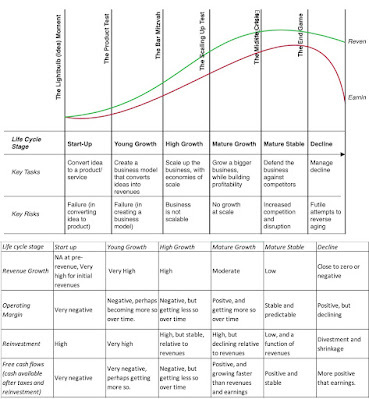
As you can see, the key tasks shift as business age, from building business models in the high growth phase to scaling up the business in high growth to defending against competition in the mature phase to managing decline int he last phase. Not surprisingly, the operating metrics change as companies age, with high revenue growth accompanied by big losses (from work-in-progress business models) and large reinvestment needs (to delivery future growth) in early-stage companies to large profits and free cash flows in the mature phase to stresses on growth and margins in decline. Consequently, in terms of cash flows, young companies burn through cash, with the burn increasing with potential, cash buildup is common as companies mature followed by cash return, as the realization kicks in that a company’s high growth days are in the past. As companies move through the life cycle, they will hit transition points in operations and in capital raising that have to be navigated, with high failure rates at each transition. Thus, most idea businesses never make it to the product phase, many product companies are unable to scale up, and quite a few scaled up firms are unable to defend their businesses from competitors. In short, the corporate life cycle has far higher mortality rates as businesses age than the human life cycle, making it imperative, if you are a business person, that you find the uncommon pathways to survive and grow.
Measures and Determinants
If you buy into the notion of a corporate life cycle, it stands to reason that you would like a way to determine where a company stands in the life cycle. There are three choices, each with pluses and minuses.
The first is to focus on corporate age, where you estimate how old a company is, relative its founding date; it is easy to obtain, but companies age at different rates (as well will argue in the following section), making it a blunt weapon.The second is to look at the industry group or sector that a company is in, and then follow up by classifying that industry group or sector into high or low growth; for the last four decades, in US equity markets, tech has been viewed as growth and utilities as mature. Here again, the problem is that high growth industry groups begin to mature, just as companies do, and this has been true for some segments of the tech sector.The third is to focus on the operating metrics of the firm, with firms that deliver high revenue growth, with low/negative profits and negative free cash flows being treated as young firms. It is more data-intensive, since making a judgment on what comprises high (revenue growth or margins) requires estimating these metrics across all firms.While I delve into the details of all three measures, corporate age works surprisingly well as a proxy for where a company falls in the life cycle, as can be seen in this table of all publicly traded companies listed globally, broken down by corporate age into ten deciles: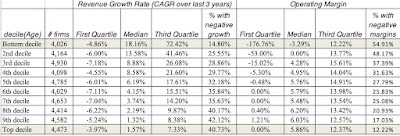
As you can see, the youngest companies have much higher revenue growth and more negative operating margins than older companies.
Ultimately, the life cycles for companies can vary on three dimensions - length (how long a business lasts), height (how much it can scale up before it plateaus) and slope (how quickly it can scale up). Even a cursory glance at the companies that surround you should tell you that there are wide variations across companies, on these dimensions. To see why, consider the factors that determine these life cycle dimensions:
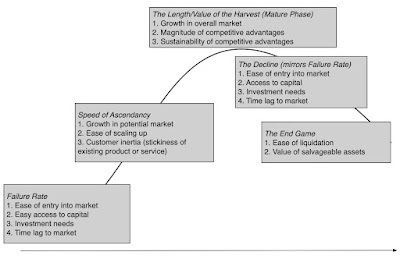 Companies in capital-light businesses, where customers are willing to switch from the status quo, can scale up much faster than companies in capital-intensive businesses, where brand names and customer inertia can make breakthroughs more difficult. It is worth noting, though, that the forces that allow a business to scale up quickly often limit how long it can stay at the top and cause decline to be quicker, a trade off that was ignored during the last decade, where scaling up was given primacy.
Companies in capital-light businesses, where customers are willing to switch from the status quo, can scale up much faster than companies in capital-intensive businesses, where brand names and customer inertia can make breakthroughs more difficult. It is worth noting, though, that the forces that allow a business to scale up quickly often limit how long it can stay at the top and cause decline to be quicker, a trade off that was ignored during the last decade, where scaling up was given primacy. The drivers of the corporate life cycle can also explain why the typical twenty-first century company faces a compressed life cycle, relative to its twentieth century counterpart. In the manufacturing-centered twentieth century, it took decades for companies like GE and Ford to scale up, but they also stayed at the top for long periods, before declining over decades. The tech-centered economy that we live in is dominated by companies that can scale up quickly, but they have brief periods at the top and scale down just as fast. Yahoo! and BlackBerry soared from start ups to being worth tens of billions of dollars in a blink of an eye, had brief reigns at the top and melted down to nothing almost as quickly.
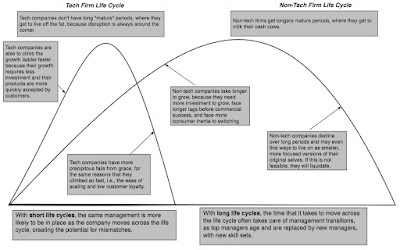 Tech companies age in dog years, and the consequences for how we manage, value and invest in them are profound. In fact, I would argue that the lessons that we teach in business school and the processes that we use in analysis need adaptation for compressed life cycle companies, and while I don't have all the answers, the discussion about changing practices is a healthy one.
Tech companies age in dog years, and the consequences for how we manage, value and invest in them are profound. In fact, I would argue that the lessons that we teach in business school and the processes that we use in analysis need adaptation for compressed life cycle companies, and while I don't have all the answers, the discussion about changing practices is a healthy one.Corporate Finance across the Life Cycle
Corporate finance, as a discipline, lays out the first principles that govern how to run a business, and with a focus on maximizing value, all decisions that a business makes can be categorized into investing (deciding what assets/projects to invest in), financing (choosing a mix of debt and equity, as well as debt type) and dividend decisions (determining how much, if any, cash to return to owners, and in what form).
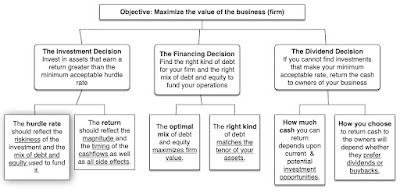
While the first principles of corporate finance do not change as a company ages, the focus and estimation processes will shift, as shown in the picture below:
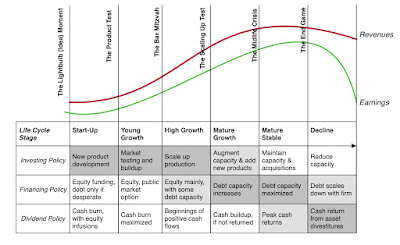
With young companies, where the bulk of the value lies in future growth, and earnings and cash flows are often negative, it is the investment decision that dominates; these companies cannot afford to borrow or pay dividends. With more mature companies, as investment opportunities become scarcer, at least relative to available capital, the focus not surprisingly shifts to financing mix, with a lower hurdle rate being the pay off. With declining businesses, facing shrinking revenues and margins, it is cash return or dividend policy that moves into the front seat.
Valuation across the Life Cycle
I am fascinated by valuation, and the link between the value of a business and its fundamentals - cash flows, growth and risk. I am also a realist and recognize that I live in a world, where pricing dominates, with what you pay for a company or asset being determined by what others are paying for similar companies and assets:
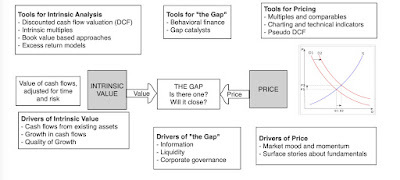 All companies can be both valued and priced, but the absence of history and high uncertainty about the future that characterizes young companies makes it more likely that pricing will dominate valuation more decisively than it does with more mature firms. All businesses, no matter where they stand in the life cycle, can be valued, but there are key differences that can be off putting to some. A well done valuation is a bridge between stories and numbers, with the interplay determining how defensible the valuation is, but the balance between stories and numbers will shift, as you move through the life cycle:
All companies can be both valued and priced, but the absence of history and high uncertainty about the future that characterizes young companies makes it more likely that pricing will dominate valuation more decisively than it does with more mature firms. All businesses, no matter where they stand in the life cycle, can be valued, but there are key differences that can be off putting to some. A well done valuation is a bridge between stories and numbers, with the interplay determining how defensible the valuation is, but the balance between stories and numbers will shift, as you move through the life cycle:
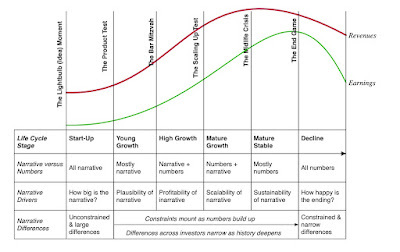 With young companies, absent historical data on growth and profitability, it is your story for the company that will drive your numbers and value. As companies age, the numbers will become more important, as the stories you tell will be constrained by what you have been able to deliver in growth and margins. If your strength as an analyst or appraiser is in bounded story telling, you will be better served valuing young companies, whereas if you are a number-cruncher (comfortable with accounting ratios and elaborate spreadsheet models), you will find valuing mature companies to be your natural habitat. The draw of pricing is strong even for those who claim to be believers in value, and pricing in its simplest form requires a standardized price (a multiple like price earnings or enterprise value to EBITDA) and a peer group. While the pricing process is the same for all companies, the pricing metrics you use and the peer groups that you compare them to will shift as companies age:
With young companies, absent historical data on growth and profitability, it is your story for the company that will drive your numbers and value. As companies age, the numbers will become more important, as the stories you tell will be constrained by what you have been able to deliver in growth and margins. If your strength as an analyst or appraiser is in bounded story telling, you will be better served valuing young companies, whereas if you are a number-cruncher (comfortable with accounting ratios and elaborate spreadsheet models), you will find valuing mature companies to be your natural habitat. The draw of pricing is strong even for those who claim to be believers in value, and pricing in its simplest form requires a standardized price (a multiple like price earnings or enterprise value to EBITDA) and a peer group. While the pricing process is the same for all companies, the pricing metrics you use and the peer groups that you compare them to will shift as companies age: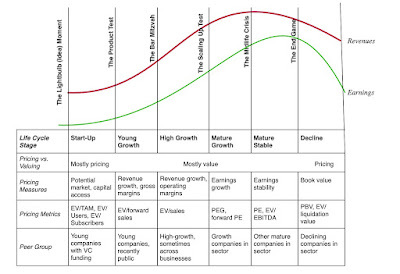
For pre-revenue and very young companies, the pricing metrics will standardize the price paid (by venture capitalists and other investors) to the number of users or subscribers that a company has or to the total market that its product is aimed at. As business models develop, and revenues come into play, you are likely to see a shift to revenue multiples, albeit often to estimated revenues in a future year (forward numbers). In the mature phase, you will see earnings multiples become more widely used, with equity versions (like PE) in peer groups where leverage is similar across companies, and enterprise value versions (EV to EBITDA) in peer groups, where leverage is different across companies. In decline, multiples of book value will become more common, with book value serving as a (poor) proxy for liquidation or break up value. In short, if you want to be open to investing in companies across the life cycle, it behooves you to become comfortable with different pricing ratios, since no one pricing multiple will work on all firms.
Investing across the Life Cycle
In my class (and book) on investment philosophies, I start by noting that every investment philosophy is rooted in a belief about markets making (and correcting) mistakes, and that there is no one best philosophy for all investors. I use the investment process, starting with asset allocation, moving to stock/asset selection and ending with execution to show the range of views that investors bring to the game:
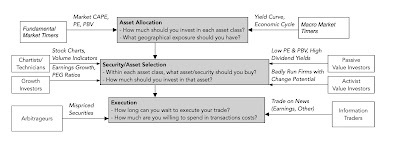 Market timing, whether it be based on charts/technical indicators or fundamentals, is primarily focused on the asset allocation phase of investing, with cheaper (based upon your market timing measures) asset classes being over weighted and more expensive asset classes being under weighted. Within the stock selection phase, there are a whole host of investment philosophies, often holding contradictory views of market behavior. Among stock traders, for instance, there are those who believe that markets learn slowly (and go with momentum) and those who believe that markets over react (and bet on reversals). On the investing side, you have the classic divide between value and growth investors, both claiming the high ground. I view the differences between these two groups through the prism of a financial balance sheet:
Market timing, whether it be based on charts/technical indicators or fundamentals, is primarily focused on the asset allocation phase of investing, with cheaper (based upon your market timing measures) asset classes being over weighted and more expensive asset classes being under weighted. Within the stock selection phase, there are a whole host of investment philosophies, often holding contradictory views of market behavior. Among stock traders, for instance, there are those who believe that markets learn slowly (and go with momentum) and those who believe that markets over react (and bet on reversals). On the investing side, you have the classic divide between value and growth investors, both claiming the high ground. I view the differences between these two groups through the prism of a financial balance sheet:
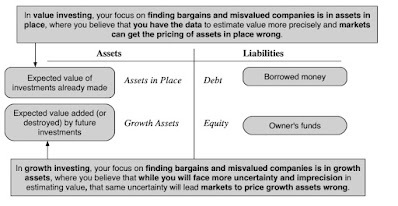
Value investors believe that the best investment bargains are in mature companies, where assets in place (investments already made) are being underpriced by the market, whereas growth investors build their investment theses around the idea that it is growth assets where markets make mistakes. Finally, there are market players who try to make money from market frictions, by locking in market mispricing (with pure or near arbitrage).
Drawing on the earlier discussion of value versus price, you can classify market players into investors (who value companies, and try to buy them at a lower price, while hoping that the gap closes) and traders (who make them money on the pricing game, buying at a low price and selling at a higher one). While investors and traders are part of the market in every company, you are likely to see the balance between the two groups shift as companies move through the life cycle:
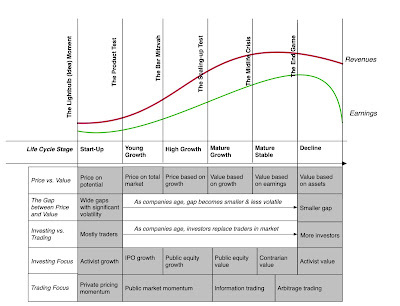
Early in the life cycle, it is undeniable that traders dominate, and for investors in these companies, even if they are right in their value assessments, winning will require much longer time horizons and stronger stomachs. As companies mature, you are likely to see more investors become part of the game, with bargain hunters entering when the stock drops too much and short sellers more willing to counter when it goes up too much. In decline, as legal and restructuring challenges mount, and a company can have multiple securities (convertibles, bonds, warrants) trading on it, hedge funds and activists become bigger players.
In sum, the investment philosophy you choose can lead you to over invest in companies in some phases of the life cycle, and while that by itself is not a problem, denying that this skew exists can become one. Thus, deep value investing, where you buy stocks that trade at low multiples of earnings and book value, will result in larger portions of the portfolio being invested in mature and declining companies. That portfolio will have the benefit of stability, but expecting it to contain ten-baggers and hundred-baggers is a reach. In contrast, a venture capital portfolio, invested almost entirely in very young companies, will have a large number of wipeouts, but it can still outperform, if it has a few large winners. Advice on concentrating your portfolio and having a margin of safety, both value investing nostrums, may work with the former but not with the latter.
Managing across the Life Cycle
Management experts who teach at business schools and populate the premier consulting firms have much to gain by propagating the myth that there is a prototype for a great CEO. After all, it gives them a reason to charge nose-bleed prices for an MBA (to be imbued with these qualities) or for consulting advice, with the same end game. The truth is that there is no one-size-fits-all for a great CEO, since the qualities that you are looking for in top management will shift as companies age:
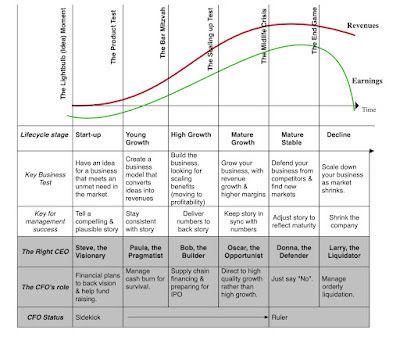 Early in the life cycle, you want a visionary at the top, since you have to get investors, employees and potential customers to buy into that vision. To turn the vision into products and services, though, you need a pragmatist, willing to accept compromises. As the focus shifts to business models, it is the business-building skills that make for a great CEO, allowing for scaling up and success. As a scaled-up business, the skill sets change again, with opportunism becoming the key quality, allowing the company to find new markets to grow in. In maturity, where playing defense becomes central, you want a top manager who can guard a company's competitive advantages fiercely. Finally, in decline, you want CEOs, unencumbered by ego or the desire to build empires, who are willing to preside over a shrinking business, with divestitures and cash returns high on the to-do list. There are very few people who have all of these skills, and it should come as no surprise that there can be a mismatch between a company and its CEO, either because they (CEO and company) age at different rates or because of hiring mistakes. Those mismatches can be catastrophic, if a headstrong CEO pushes ahead with actions that are unsuited to the company he or she is in charge off, but they can be benign, if the mismatched CEO can find a partner who can fill in for weaknesses:
Early in the life cycle, you want a visionary at the top, since you have to get investors, employees and potential customers to buy into that vision. To turn the vision into products and services, though, you need a pragmatist, willing to accept compromises. As the focus shifts to business models, it is the business-building skills that make for a great CEO, allowing for scaling up and success. As a scaled-up business, the skill sets change again, with opportunism becoming the key quality, allowing the company to find new markets to grow in. In maturity, where playing defense becomes central, you want a top manager who can guard a company's competitive advantages fiercely. Finally, in decline, you want CEOs, unencumbered by ego or the desire to build empires, who are willing to preside over a shrinking business, with divestitures and cash returns high on the to-do list. There are very few people who have all of these skills, and it should come as no surprise that there can be a mismatch between a company and its CEO, either because they (CEO and company) age at different rates or because of hiring mistakes. Those mismatches can be catastrophic, if a headstrong CEO pushes ahead with actions that are unsuited to the company he or she is in charge off, but they can be benign, if the mismatched CEO can find a partner who can fill in for weaknesses:

While the possibilities of mismatches have always been part of business, the compression of corporate life cycles has made them both much more likely, as well as more damaging. After all, time took care of management transitions for long-lived twentieth century firms, but with firms that can scale up to become market cap giants in a decade, before scaling down and disappearing in the next one, you can very well see a founder/CEO go from being a hero in one phase to a zero in the next one. As we have allowed many of the most successful firms that have gone public in this century to skew the corporate finance game, with shares with different voting rights, we may be losing our power to change management at those firms where the need for change is greatest.
Aging gracefully?
The healthiest response to aging is acceptance, where a business accepts where it is in the life cycle, and behaves accordingly. Thus, a young firm that derives much of its value from future growth should not put that at risk by borrowing money or by buying back stock, just as a mature firm, where value comes from its existing assets and competitive advantages, should not risk that value by acquiring companies in new and unfamiliar businesses, in an attempt to return to its growth days. Acceptance is most difficult for declining firms, since the management and investors have to make peace with downsizing the firm. For these firms, it is worth emphasizing that acceptance does not imply passivity, a distorted and defeatist view of karma, where you do nothing in the face of decline, but requires actions that allow the firm to navigate the process with the least pain and most value to its stakeholders.
It should come as no surprise that many firms, especially in decline, choose denial, where managers and investors come up with excuses for poor performance and lay blame on outside factors. On this path, declining firms will continue to act the way they did when they were mature or even growth companies, with large costs to everyone involved. When the promised turnaround does not ensue, desperation becomes the alternative path, with managers gambling large sums of other people’s money on long shots, with predictable results.
The siren song that draws declining firms to make these attempts to recreate themselves, is the hope of a rebirth, and an ecosystem of bankers and consultants offers them magic potions (taking the form of proprietary acronyms that either restate the obvious or are built on foundations of made-up data) that will make them young again. They are aided and abetted by case studies of companies that found pathways to reincarnation (IBM in 1992, Apple in 2000 and Microsoft in 2013), with the added bonus that their CEOs were elevated to legendary status. While it is undeniable that companies do sometimes reincarnate, it is worth recognizing that they remain the exception rather than the rule, and while their top management deserves plaudits, luck played a key role as well.
I am a skeptic on sustainability, at least as applied to companies, since its makes corporate survival the end game, sometimes with substantial costs for many stakeholders, as well as for society. Like the Egyptian Pharaohs who sought immortality by wrapping their bodies in bandages and being buried with their favorite possessions, companies that seek to live forever will become mummies (and sometimes zombies), sucking up resources that could be better used elsewhere.
In conclusion
It is the dream, in every discipline, to come up with a theory or construct that explains everything in that disciple. Unlike the physical sciences, where that search is constrained by the laws of nature, the social sciences reflect more trial and error, with the unpredictability of human nature being the wild card. In finance, a discipline that started as an offshoot of economics in the 1950s, that search began with theory-based models, with portfolio theory and the CAPM, veered into data-based constructs (proxy models, factor analysis), and behavioral finance, with its marriage of finance and psychology. I am grateful for those contributions, but the corporate life cycle has offered me a low-tech, but surprisingly wide reaching, construct to explain much of what I see in business and investment behavior.
If you find yourself interested in the topic, you can try the book, and in the interests of making it accessible to a diverse reader base, I have tried to make it both modular and self-standing. Thus, if you are interested in how running a business changes, as it ages, you can focus on the four chapters that look at corporate finance implications, with the lead-in chapter providing you enough of a corporate finance foundation (even if you have never taken a corporate finance class) to be able to understand the investing, financing and dividend effects. If you are an appraiser or analyst, interested in valuing companies across the life cycle, it is the five chapters on valuation that may draw your interest, again with a lead-in chapter containing an introduction to valuation and pricing. As an investor, no matter what your investment philosophy, it is the four chapters on investing across the life cycle that may appeal to you the most. While I am sure that you will have no trouble finding the book, I have a list of book retailers listed below that you can use, if you choose, and the webpage supporting the book can be found here.
If you are budget-constrained or just don't like reading (and there is no shame in that), I have also created an online class, with twenty sessions of 25-35 minutes apiece, that delivers the material from the book. It includes exercises that you can use to check your understanding, and the link to the class is here.
YouTube Video
Book and Class Webpages
Book webpage: https://pages.stern.nyu.edu/~adamodar//New_Home_Page/CLC.htmClass webpage: https://pages.stern.nyu.edu/~adamodar//New_Home_Page/webcastCLC.htmYouTube Playlist for class: https://www.youtube.com/playlist?list=PLUkh9m2BorqlpbJBd26UEawPHk0k9y04_Links to booksellers
Amazon: https://www.amazon.com/Corporate-Lifecycle-Investment-Management-Implications/dp/0593545060Barnes & Noble: https://www.barnesandnoble.com/w/the-corporate-life-cycle-aswath-damodaran/1143170651?ean=9780593545065Bookshop.org: https://bookshop.org/p/books/the-corporate-lifecycle-business-investment-and-management-implications-aswath-damodaran/19850366?ean=9780593545065Apple: https://books.apple.com/us/audiobook/the-corporate-life-cycle-business-investment/id1680865376(There is an Indian edition that will be released in September, which should be available in bookstores there.)The Corporate Life Cycle: Corporate Finance, Valuation and Investing Implications!
As I reveal my ignorance about TikTok trends, social media celebrities and Gen Z slang, my children are quick to point out my age, and I accept that reality, for the most part. I understand that I am too old to exercise without stretching first or eat a heaping plate of cheese fries and not suffer heartburn, but that does not stop me from trying occasionally. For the last decade or so, I have argued that businesses, like human beings, age, and struggle with aging, and that much of the dysfunction we observe in their decision making stems from refusing to act their age. In fact, the business life cycle has become an integral part of the corporate finance, valuation and investing classes that I teach, and in many of the posts that I have written on this blog. In 2022, I decided that I had hit critical mass, in terms of corporate life cycle content, and that the material could be organized as a book. While the writing for the book was largely done by November 2022, publishing does have a long lead time, and the book, published by Penguin Random House, will be available on August 20, 2024, at a book shop near you. If you are concerned that you are going to be hit with a sales pitch for that book, far from it! Rather than try to part you from your money, I thought I would give a compressed version of the book in this post, and for most of you, that will suffice.
Setting the Stage
The notion of a business life cycle is neither new nor original, since versions of it have floated around in management circles for decades, but its applications in finance have been spotty, with some attempts to tie where a company is in the life cycle to its corporate governance and others to accounting ratios. In fact, and this should come as no surprise to anyone who is familiar with his work, the most incisive piece tying excess returns (return on invested capital minus cost of capital) to the corporate life cycle was penned by Michael Mauboussin (with Dan Callahan) just a few months ago. My version of the corporate life cycle is built around six stages with the first stage being an idea business (a start-up) and the last one representing decline and demise.
As you can see, the key tasks shift as business age, from building business models in the high growth phase to scaling up the business in high growth to defending against competition in the mature phase to managing decline int he last phase. Not surprisingly, the operating metrics change as companies age, with high revenue growth accompanied by big losses (from work-in-progress business models) and large reinvestment needs (to delivery future growth) in early-stage companies to large profits and free cash flows in the mature phase to stresses on growth and margins in decline. Consequently, in terms of cash flows, young companies burn through cash, with the burn increasing with potential, cash buildup is common as companies mature followed by cash return, as the realization kicks in that a company’s high growth days are in the past. As companies move through the life cycle, they will hit transition points in operations and in capital raising that have to be navigated, with high failure rates at each transition. Thus, most idea businesses never make it to the product phase, many product companies are unable to scale up, and quite a few scaled up firms are unable to defend their businesses from competitors. In short, the corporate life cycle has far higher mortality rates as businesses age than the human life cycle, making it imperative, if you are a business person, that you find the uncommon pathways to survive and grow.
Measures and Determinants
If you buy into the notion of a corporate life cycle, it stands to reason that you would like a way to determine where a company stands in the life cycle. There are three choices, each with pluses and minuses.
The first is to focus on corporate age, where you estimate how old a company is, relative its founding date; it is easy to obtain, but companies age at different rates (as well will argue in the following section), making it a blunt weapon.The second is to look at the industry group or sector that a company is in, and then follow up by classifying that industry group or sector into high or low growth; for the last four decades, in US equity markets, tech has been viewed as growth and utilities as mature. Here again, the problem is that high growth industry groups begin to mature, just as companies do, and this has been true for some segments of the tech sector.The third is to focus on the operating metrics of the firm, with firms that deliver high revenue growth, with low/negative profits and negative free cash flows being treated as young firms. It is more data-intensive, since making a judgment on what comprises high (revenue growth or margins) requires estimating these metrics across all firms.While I delve into the details of all three measures, corporate age works surprisingly well as a proxy for where a company falls in the life cycle, as can be seen in this table of all publicly traded companies listed globally, broken down by corporate age into ten deciles:
As you can see, the youngest companies have much higher revenue growth and more negative operating margins than older companies.
Ultimately, the life cycles for companies can vary on three dimensions - length (how long a business lasts), height (how much it can scale up before it plateaus) and slope (how quickly it can scale up). Even a cursory glance at the companies that surround you should tell you that there are wide variations across companies, on these dimensions. To see why, consider the factors that determine these life cycle dimensions:
 Companies in capital-light businesses, where customers are willing to switch from the status quo, can scale up much faster than companies in capital-intensive businesses, where brand names and customer inertia can make breakthroughs more difficult. It is worth noting, though, that the forces that allow a business to scale up quickly often limit how long it can stay at the top and cause decline to be quicker, a trade off that was ignored during the last decade, where scaling up was given primacy.
Companies in capital-light businesses, where customers are willing to switch from the status quo, can scale up much faster than companies in capital-intensive businesses, where brand names and customer inertia can make breakthroughs more difficult. It is worth noting, though, that the forces that allow a business to scale up quickly often limit how long it can stay at the top and cause decline to be quicker, a trade off that was ignored during the last decade, where scaling up was given primacy. The drivers of the corporate life cycle can also explain why the typical twenty-first century company faces a compressed life cycle, relative to its twentieth century counterpart. In the manufacturing-centered twentieth century, it took decades for companies like GE and Ford to scale up, but they also stayed at the top for long periods, before declining over decades. The tech-centered economy that we live in is dominated by companies that can scale up quickly, but they have brief periods at the top and scale down just as fast. Yahoo! and BlackBerry soared from start ups to being worth tens of billions of dollars in a blink of an eye, had brief reigns at the top and melted down to nothing almost as quickly.
 Tech companies age in dog years, and the consequences for how we manage, value and invest in them are profound. In fact, I would argue that the lessons that we teach in business school and the processes that we use in analysis need adaptation for compressed life cycle companies, and while I don't have all the answers, the discussion about changing practices is a healthy one.
Tech companies age in dog years, and the consequences for how we manage, value and invest in them are profound. In fact, I would argue that the lessons that we teach in business school and the processes that we use in analysis need adaptation for compressed life cycle companies, and while I don't have all the answers, the discussion about changing practices is a healthy one.Corporate Finance across the Life Cycle
Corporate finance, as a discipline, lays out the first principles that govern how to run a business, and with a focus on maximizing value, all decisions that a business makes can be categorized into investing (deciding what assets/projects to invest in), financing (choosing a mix of debt and equity, as well as debt type) and dividend decisions (determining how much, if any, cash to return to owners, and in what form).

While the first principles of corporate finance do not change as a company ages, the focus and estimation processes will shift, as shown in the picture below:

With young companies, where the bulk of the value lies in future growth, and earnings and cash flows are often negative, it is the investment decision that dominates; these companies cannot afford to borrow or pay dividends. With more mature companies, as investment opportunities become scarcer, at least relative to available capital, the focus not surprisingly shifts to financing mix, with a lower hurdle rate being the pay off. With declining businesses, facing shrinking revenues and margins, it is cash return or dividend policy that moves into the front seat.
Valuation across the Life Cycle
I am fascinated by valuation, and the link between the value of a business and its fundamentals - cash flows, growth and risk. I am also a realist and recognize that I live in a world, where pricing dominates, with what you pay for a company or asset being determined by what others are paying for similar companies and assets:
 All companies can be both valued and priced, but the absence of history and high uncertainty about the future that characterizes young companies makes it more likely that pricing will dominate valuation more decisively than it does with more mature firms. All businesses, no matter where they stand in the life cycle, can be valued, but there are key differences that can be off putting to some. A well done valuation is a bridge between stories and numbers, with the interplay determining how defensible the valuation is, but the balance between stories and numbers will shift, as you move through the life cycle:
All companies can be both valued and priced, but the absence of history and high uncertainty about the future that characterizes young companies makes it more likely that pricing will dominate valuation more decisively than it does with more mature firms. All businesses, no matter where they stand in the life cycle, can be valued, but there are key differences that can be off putting to some. A well done valuation is a bridge between stories and numbers, with the interplay determining how defensible the valuation is, but the balance between stories and numbers will shift, as you move through the life cycle:
 With young companies, absent historical data on growth and profitability, it is your story for the company that will drive your numbers and value. As companies age, the numbers will become more important, as the stories you tell will be constrained by what you have been able to deliver in growth and margins. If your strength as an analyst or appraiser is in bounded story telling, you will be better served valuing young companies, whereas if you are a number-cruncher (comfortable with accounting ratios and elaborate spreadsheet models), you will find valuing mature companies to be your natural habitat. The draw of pricing is strong even for those who claim to be believers in value, and pricing in its simplest form requires a standardized price (a multiple like price earnings or enterprise value to EBITDA) and a peer group. While the pricing process is the same for all companies, the pricing metrics you use and the peer groups that you compare them to will shift as companies age:
With young companies, absent historical data on growth and profitability, it is your story for the company that will drive your numbers and value. As companies age, the numbers will become more important, as the stories you tell will be constrained by what you have been able to deliver in growth and margins. If your strength as an analyst or appraiser is in bounded story telling, you will be better served valuing young companies, whereas if you are a number-cruncher (comfortable with accounting ratios and elaborate spreadsheet models), you will find valuing mature companies to be your natural habitat. The draw of pricing is strong even for those who claim to be believers in value, and pricing in its simplest form requires a standardized price (a multiple like price earnings or enterprise value to EBITDA) and a peer group. While the pricing process is the same for all companies, the pricing metrics you use and the peer groups that you compare them to will shift as companies age:
For pre-revenue and very young companies, the pricing metrics will standardize the price paid (by venture capitalists and other investors) to the number of users or subscribers that a company has or to the total market that its product is aimed at. As business models develop, and revenues come into play, you are likely to see a shift to revenue multiples, albeit often to estimated revenues in a future year (forward numbers). In the mature phase, you will see earnings multiples become more widely used, with equity versions (like PE) in peer groups where leverage is similar across companies, and enterprise value versions (EV to EBITDA) in peer groups, where leverage is different across companies. In decline, multiples of book value will become more common, with book value serving as a (poor) proxy for liquidation or break up value. In short, if you want to be open to investing in companies across the life cycle, it behooves you to become comfortable with different pricing ratios, since no one pricing multiple will work on all firms.
Investing across the Life Cycle
In my class (and book) on investment philosophies, I start by noting that every investment philosophy is rooted in a belief about markets making (and correcting) mistakes, and that there is no one best philosophy for all investors. I use the investment process, starting with asset allocation, moving to stock/asset selection and ending with execution to show the range of views that investors bring to the game:
 Market timing, whether it be based on charts/technical indicators or fundamentals, is primarily focused on the asset allocation phase of investing, with cheaper (based upon your market timing measures) asset classes being over weighted and more expensive asset classes being under weighted. Within the stock selection phase, there are a whole host of investment philosophies, often holding contradictory views of market behavior. Among stock traders, for instance, there are those who believe that markets learn slowly (and go with momentum) and those who believe that markets over react (and bet on reversals). On the investing side, you have the classic divide between value and growth investors, both claiming the high ground. I view the differences between these two groups through the prism of a financial balance sheet:
Market timing, whether it be based on charts/technical indicators or fundamentals, is primarily focused on the asset allocation phase of investing, with cheaper (based upon your market timing measures) asset classes being over weighted and more expensive asset classes being under weighted. Within the stock selection phase, there are a whole host of investment philosophies, often holding contradictory views of market behavior. Among stock traders, for instance, there are those who believe that markets learn slowly (and go with momentum) and those who believe that markets over react (and bet on reversals). On the investing side, you have the classic divide between value and growth investors, both claiming the high ground. I view the differences between these two groups through the prism of a financial balance sheet:

Value investors believe that the best investment bargains are in mature companies, where assets in place (investments already made) are being underpriced by the market, whereas growth investors build their investment theses around the idea that it is growth assets where markets make mistakes. Finally, there are market players who try to make money from market frictions, by locking in market mispricing (with pure or near arbitrage).
Drawing on the earlier discussion of value versus price, you can classify market players into investors (who value companies, and try to buy them at a lower price, while hoping that the gap closes) and traders (who make them money on the pricing game, buying at a low price and selling at a higher one). While investors and traders are part of the market in every company, you are likely to see the balance between the two groups shift as companies move through the life cycle:

Early in the life cycle, it is undeniable that traders dominate, and for investors in these companies, even if they are right in their value assessments, winning will require much longer time horizons and stronger stomachs. As companies mature, you are likely to see more investors become part of the game, with bargain hunters entering when the stock drops too much and short sellers more willing to counter when it goes up too much. In decline, as legal and restructuring challenges mount, and a company can have multiple securities (convertibles, bonds, warrants) trading on it, hedge funds and activists become bigger players.
In sum, the investment philosophy you choose can lead you to over invest in companies in some phases of the life cycle, and while that by itself is not a problem, denying that this skew exists can become one. Thus, deep value investing, where you buy stocks that trade at low multiples of earnings and book value, will result in larger portions of the portfolio being invested in mature and declining companies. That portfolio will have the benefit of stability, but expecting it to contain ten-baggers and hundred-baggers is a reach. In contrast, a venture capital portfolio, invested almost entirely in very young companies, will have a large number of wipeouts, but it can still outperform, if it has a few large winners. Advice on concentrating your portfolio and having a margin of safety, both value investing nostrums, may work with the former but not with the latter.
Managing across the Life Cycle
Management experts who teach at business schools and populate the premier consulting firms have much to gain by propagating the myth that there is a prototype for a great CEO. After all, it gives them a reason to charge nose-bleed prices for an MBA (to be imbued with these qualities) or for consulting advice, with the same end game. The truth is that there is no one-size-fits-all for a great CEO, since the qualities that you are looking for in top management will shift as companies age:
 Early in the life cycle, you want a visionary at the top, since you have to get investors, employees and potential customers to buy into that vision. To turn the vision into products and services, though, you need a pragmatist, willing to accept compromises. As the focus shifts to business models, it is the business-building skills that make for a great CEO, allowing for scaling up and success. As a scaled-up business, the skill sets change again, with opportunism becoming the key quality, allowing the company to find new markets to grow in. In maturity, where playing defense becomes central, you want a top manager who can guard a company's competitive advantages fiercely. Finally, in decline, you want CEOs, unencumbered by ego or the desire to build empires, who are willing to preside over a shrinking business, with divestitures and cash returns high on the to-do list. There are very few people who have all of these skills, and it should come as no surprise that there can be a mismatch between a company and its CEO, either because they (CEO and company) age at different rates or because of hiring mistakes. Those mismatches can be catastrophic, if a headstrong CEO pushes ahead with actions that are unsuited to the company he or she is in charge off, but they can be benign, if the mismatched CEO can find a partner who can fill in for weaknesses:
Early in the life cycle, you want a visionary at the top, since you have to get investors, employees and potential customers to buy into that vision. To turn the vision into products and services, though, you need a pragmatist, willing to accept compromises. As the focus shifts to business models, it is the business-building skills that make for a great CEO, allowing for scaling up and success. As a scaled-up business, the skill sets change again, with opportunism becoming the key quality, allowing the company to find new markets to grow in. In maturity, where playing defense becomes central, you want a top manager who can guard a company's competitive advantages fiercely. Finally, in decline, you want CEOs, unencumbered by ego or the desire to build empires, who are willing to preside over a shrinking business, with divestitures and cash returns high on the to-do list. There are very few people who have all of these skills, and it should come as no surprise that there can be a mismatch between a company and its CEO, either because they (CEO and company) age at different rates or because of hiring mistakes. Those mismatches can be catastrophic, if a headstrong CEO pushes ahead with actions that are unsuited to the company he or she is in charge off, but they can be benign, if the mismatched CEO can find a partner who can fill in for weaknesses:

While the possibilities of mismatches have always been part of business, the compression of corporate life cycles has made them both much more likely, as well as more damaging. After all, time took care of management transitions for long-lived twentieth century firms, but with firms that can scale up to become market cap giants in a decade, before scaling down and disappearing in the next one, you can very well see a founder/CEO go from being a hero in one phase to a zero in the next one. As we have allowed many of the most successful firms that have gone public in this century to skew the corporate finance game, with shares with different voting rights, we may be losing our power to change management at those firms where the need for change is greatest.
Aging gracefully?
The healthiest response to aging is acceptance, where a business accepts where it is in the life cycle, and behaves accordingly. Thus, a young firm that derives much of its value from future growth should not put that at risk by borrowing money or by buying back stock, just as a mature firm, where value comes from its existing assets and competitive advantages, should not risk that value by acquiring companies in new and unfamiliar businesses, in an attempt to return to its growth days. Acceptance is most difficult for declining firms, since the management and investors have to make peace with downsizing the firm. For these firms, it is worth emphasizing that acceptance does not imply passivity, a distorted and defeatist view of karma, where you do nothing in the face of decline, but requires actions that allow the firm to navigate the process with the least pain and most value to its stakeholders.
It should come as no surprise that many firms, especially in decline, choose denial, where managers and investors come up with excuses for poor performance and lay blame on outside factors. On this path, declining firms will continue to act the way they did when they were mature or even growth companies, with large costs to everyone involved. When the promised turnaround does not ensue, desperation becomes the alternative path, with managers gambling large sums of other people’s money on long shots, with predictable results.
The siren song that draws declining firms to make these attempts to recreate themselves, is the hope of a rebirth, and an ecosystem of bankers and consultants offers them magic potions (taking the form of proprietary acronyms that either restate the obvious or are built on foundations of made-up data) that will make them young again. They are aided and abetted by case studies of companies that found pathways to reincarnation (IBM in 1992, Apple in 2000 and Microsoft in 2013), with the added bonus that their CEOs were elevated to legendary status. While it is undeniable that companies do sometimes reincarnate, it is worth recognizing that they remain the exception rather than the rule, and while their top management deserves plaudits, luck played a key role as well.
I am a skeptic on sustainability, at least as applied to companies, since its makes corporate survival the end game, sometimes with substantial costs for many stakeholders, as well as for society. Like the Egyptian Pharaohs who sought immortality by wrapping their bodies in bandages and being buried with their favorite possessions, companies that seek to live forever will become mummies (and sometimes zombies), sucking up resources that could be better used elsewhere.
In conclusion
It is the dream, in every discipline, to come up with a theory or construct that explains everything in that disciple. Unlike the physical sciences, where that search is constrained by the laws of nature, the social sciences reflect more trial and error, with the unpredictability of human nature being the wild card. In finance, a discipline that started as an offshoot of economics in the 1950s, that search began with theory-based models, with portfolio theory and the CAPM, veered into data-based constructs (proxy models, factor analysis), and behavioral finance, with its marriage of finance and psychology. I am grateful for those contributions, but the corporate life cycle has offered me a low-tech, but surprisingly wide reaching, construct to explain much of what I see in business and investment behavior.
If you find yourself interested in the topic, you can try the book, and in the interests of making it accessible to a diverse reader base, I have tried to make it both modular and self-standing. Thus, if you are interested in how running a business changes, as it ages, you can focus on the four chapters that look at corporate finance implications, with the lead-in chapter providing you enough of a corporate finance foundation (even if you have never taken a corporate finance class) to be able to understand the investing, financing and dividend effects. If you are an appraiser or analyst, interested in valuing companies across the life cycle, it is the five chapters on valuation that may draw your interest, again with a lead-in chapter containing an introduction to valuation and pricing. As an investor, no matter what your investment philosophy, it is the four chapters on investing across the life cycle that may appeal to you the most. While I am sure that you will have no trouble finding the book, I have a list of book retailers listed below that you can use, if you choose, and the webpage supporting the book can be found here.
If you are budget-constrained or just don't like reading (and there is no shame in that), I have also created an online class, with twenty sessions of 25-35 minutes apiece, that delivers the material from the book. It includes exercises that you can use to check your understanding, and the link to the class is here.
YouTube Video
Book and Class Webpages
Book webpage: https://pages.stern.nyu.edu/~adamodar//New_Home_Page/CLC.htmClass webpage: https://pages.stern.nyu.edu/~adamodar//New_Home_Page/webcastCLC.htmYouTube Playlist for class: https://www.youtube.com/playlist?list=PLUkh9m2BorqlpbJBd26UEawPHk0k9y04_Links to booksellers
Amazon: https://www.amazon.com/Corporate-Lifecycle-Investment-Management-Implications/dp/0593545060Barnes & Noble: https://www.barnesandnoble.com/w/the-corporate-life-cycle-aswath-damodaran/1143170651?ean=9780593545065Bookshop.org: https://bookshop.org/p/books/the-corporate-lifecycle-business-investment-and-management-implications-aswath-damodaran/19850366?ean=9780593545065Apple: https://books.apple.com/us/audiobook/the-corporate-life-cycle-business-investment/id1680865376(There is an Indian edition that will be released in September, which should be available in bookstores there.)Aswath Damodaran's Blog
- Aswath Damodaran's profile
- 725 followers



